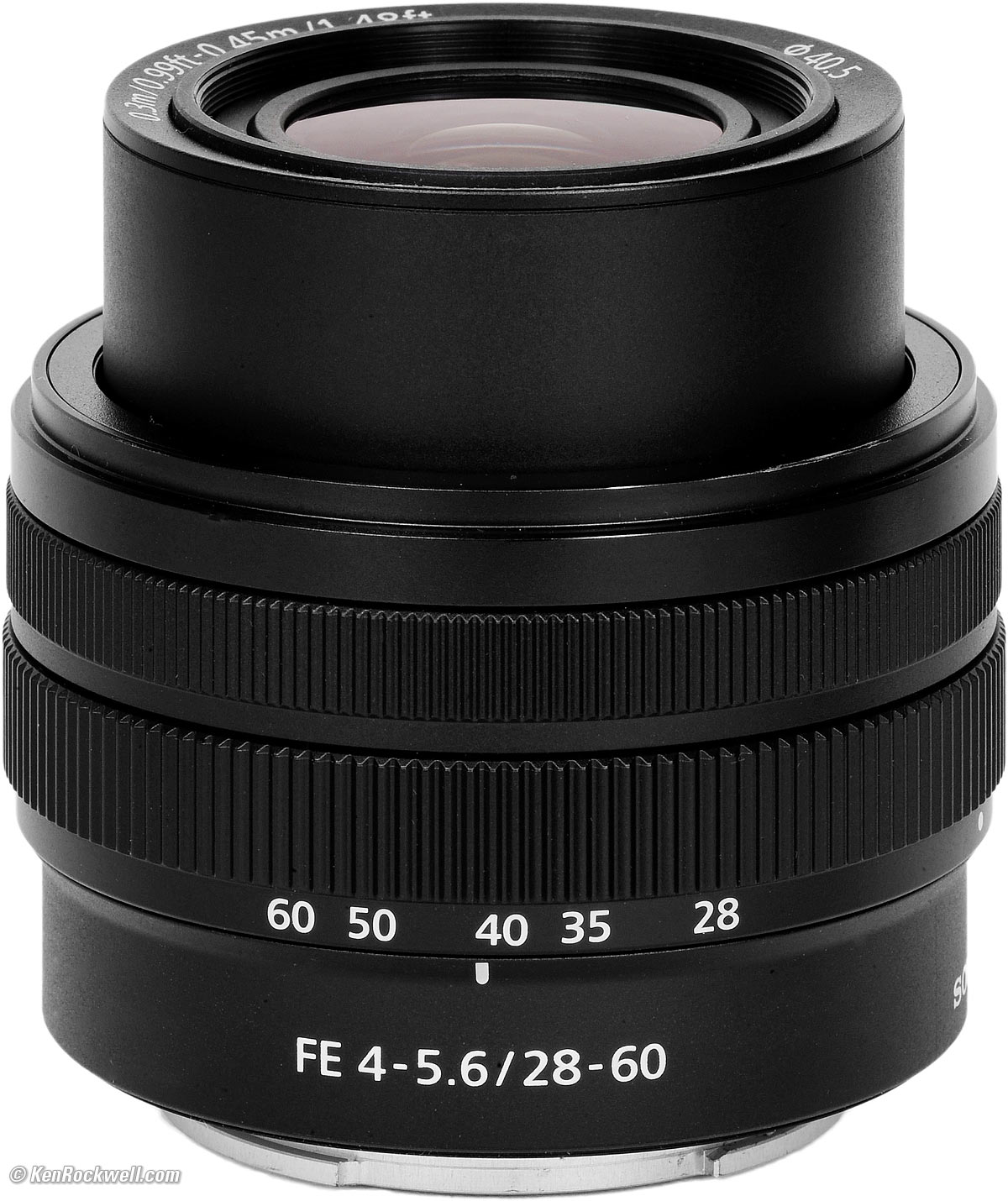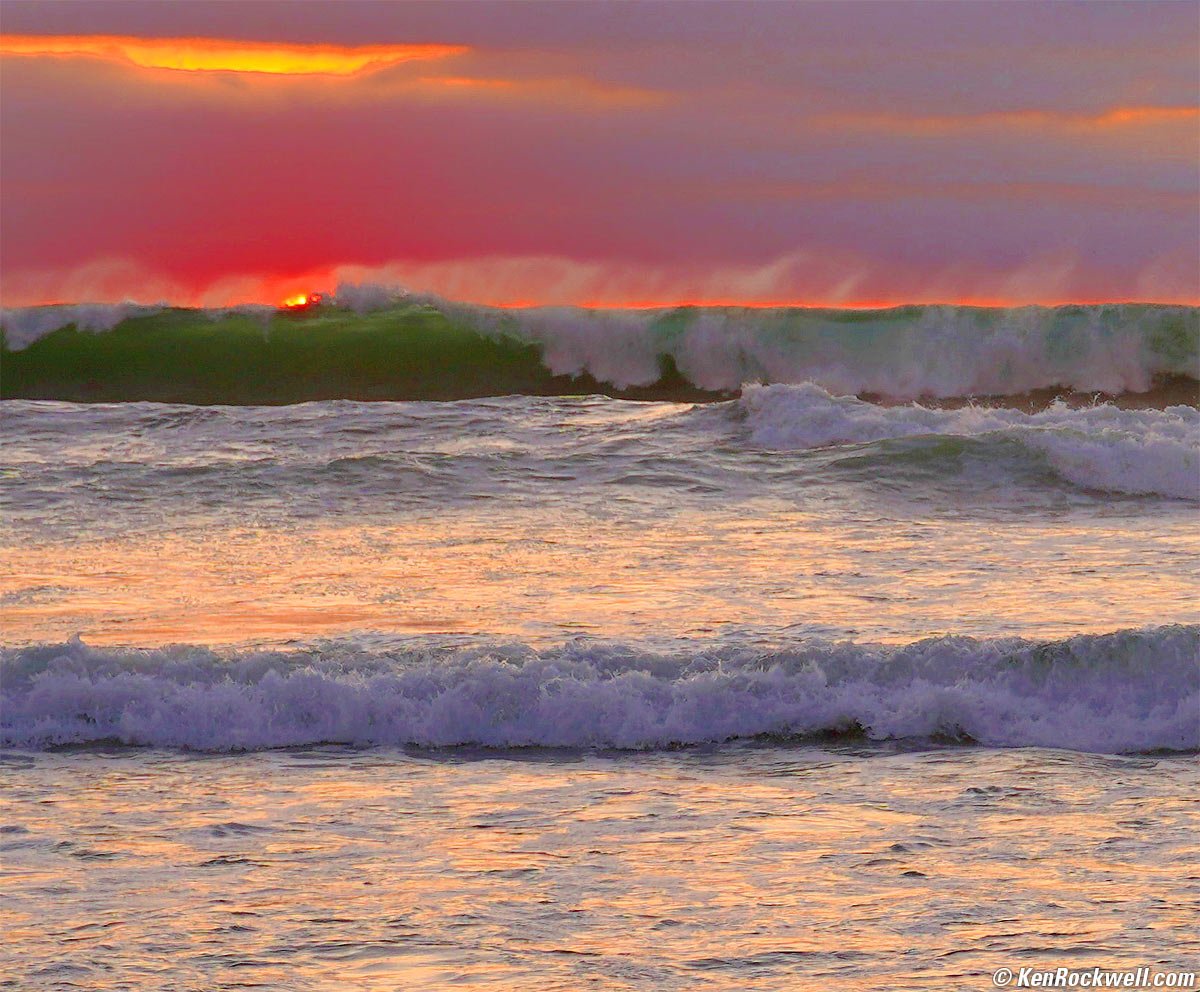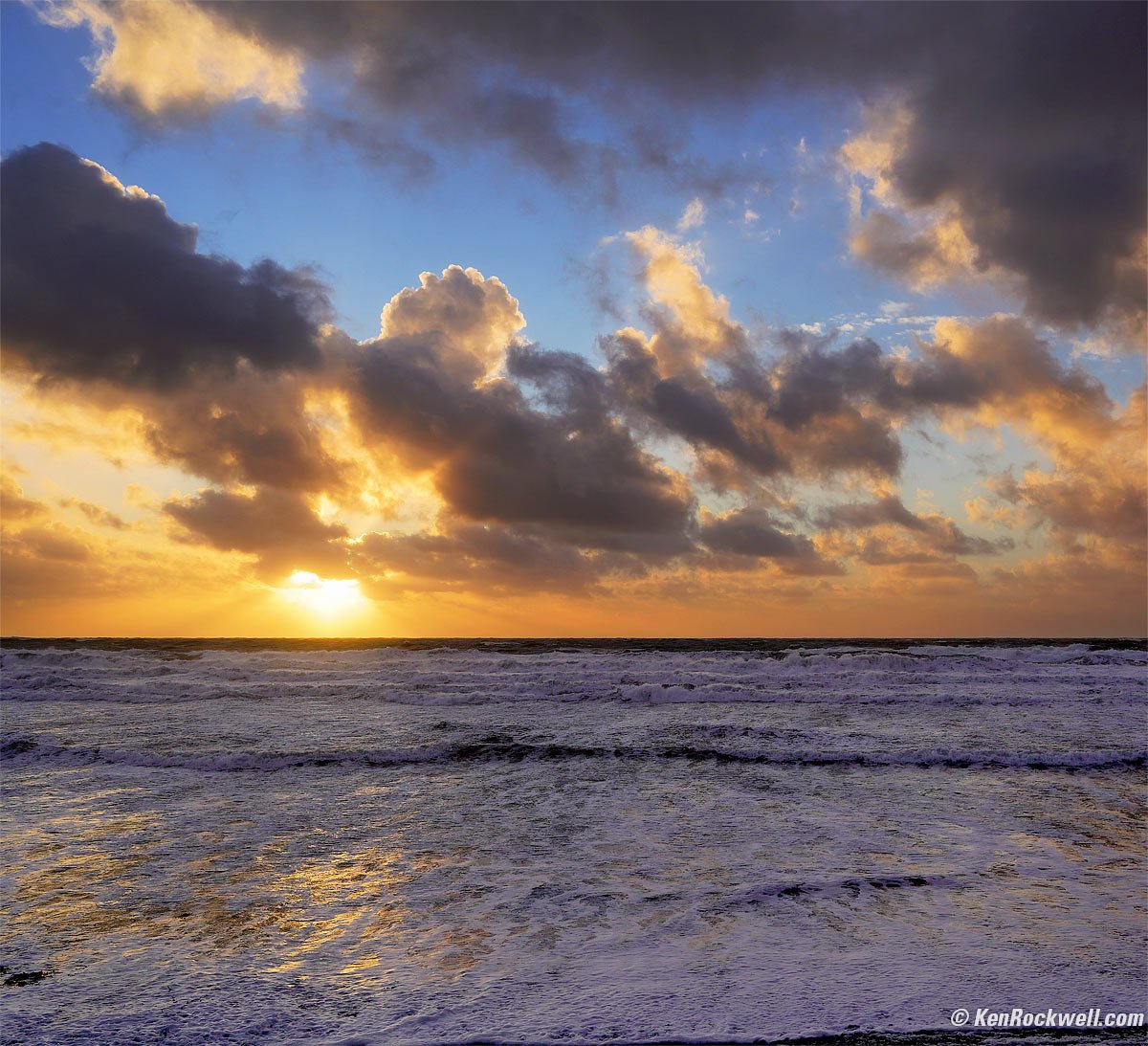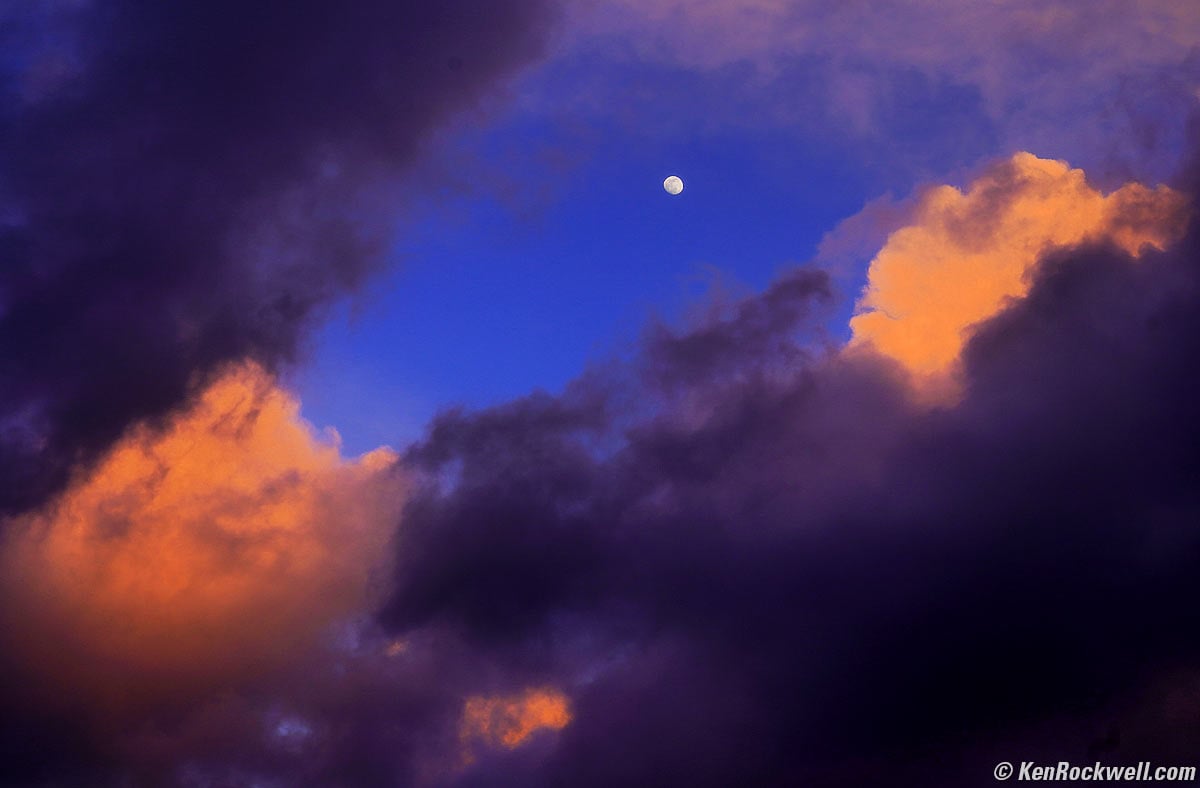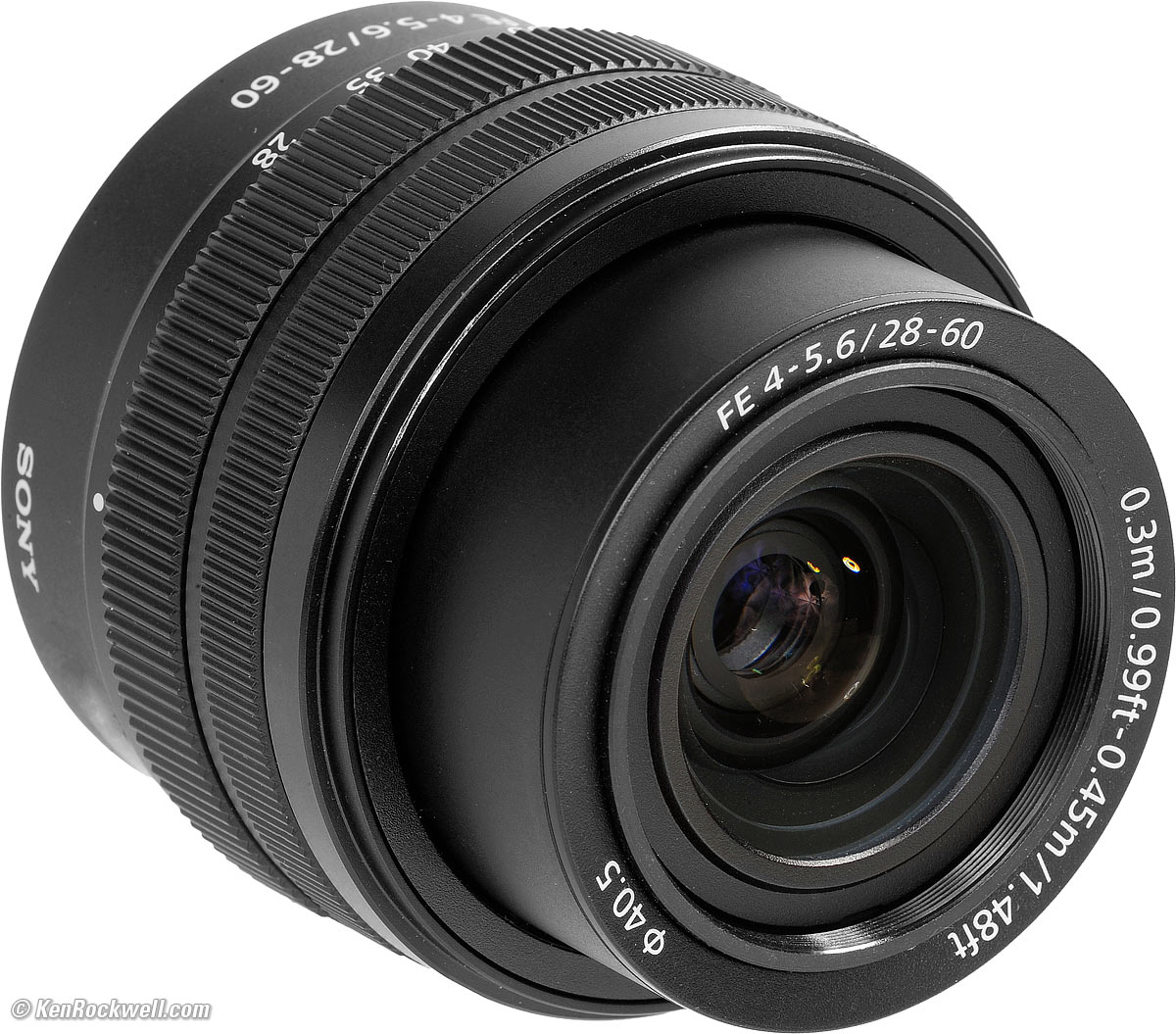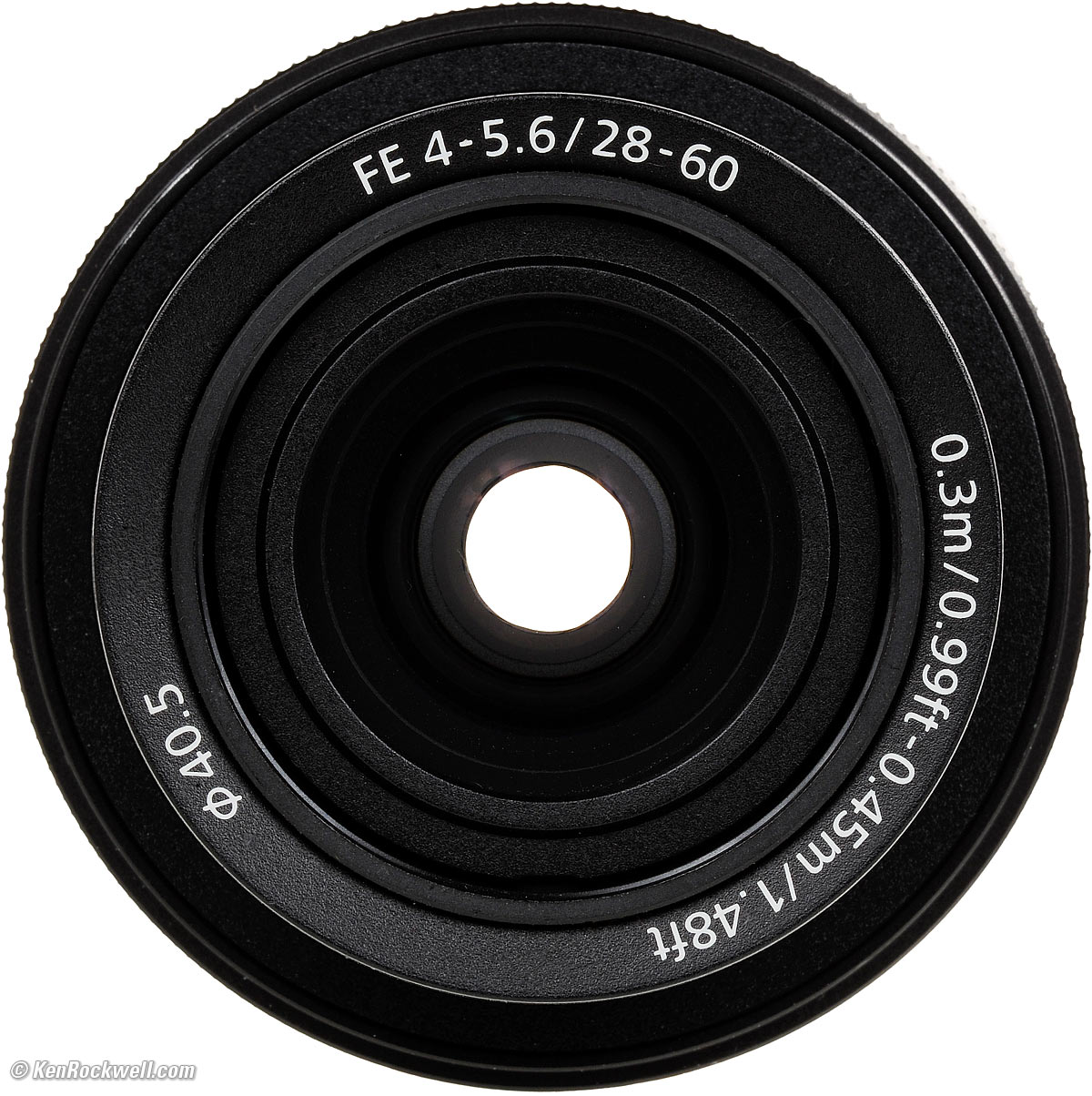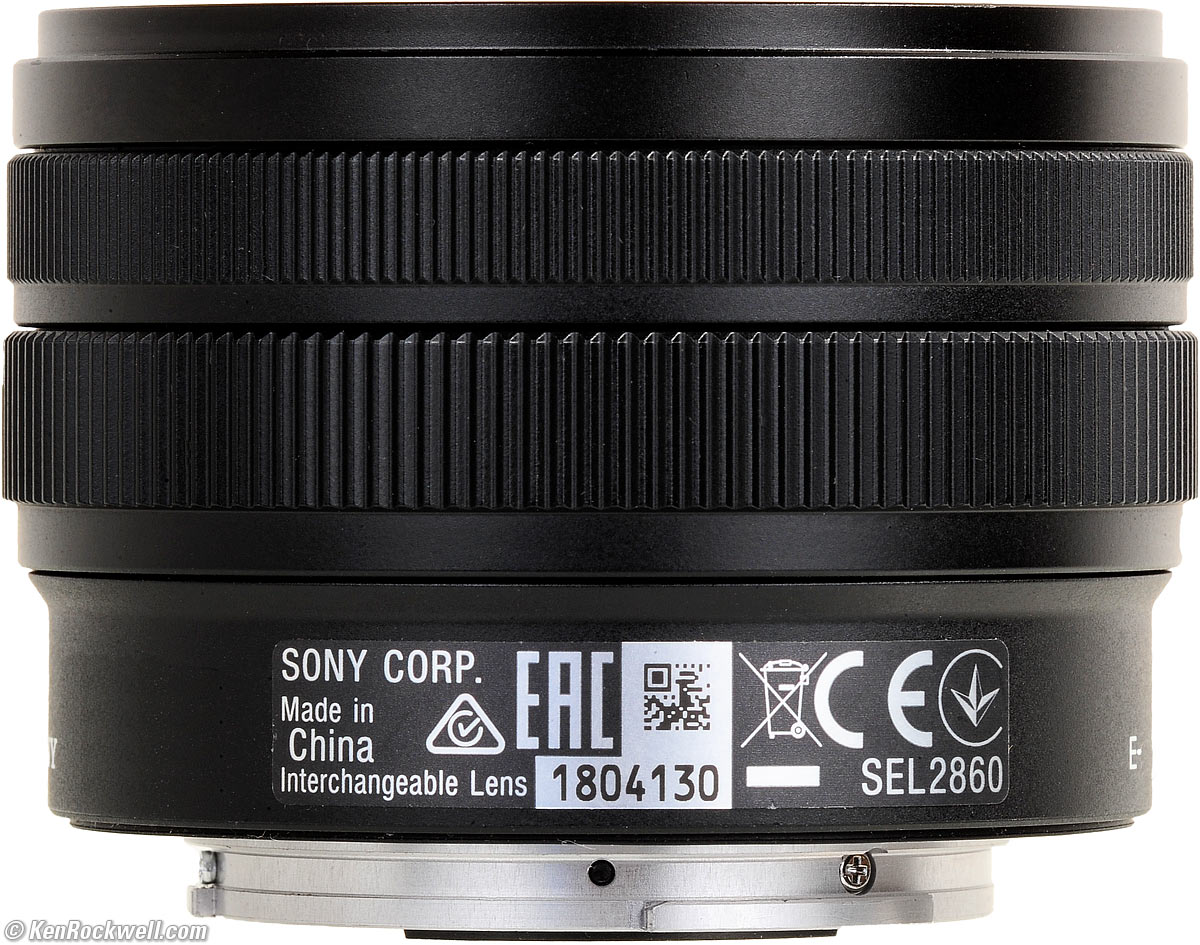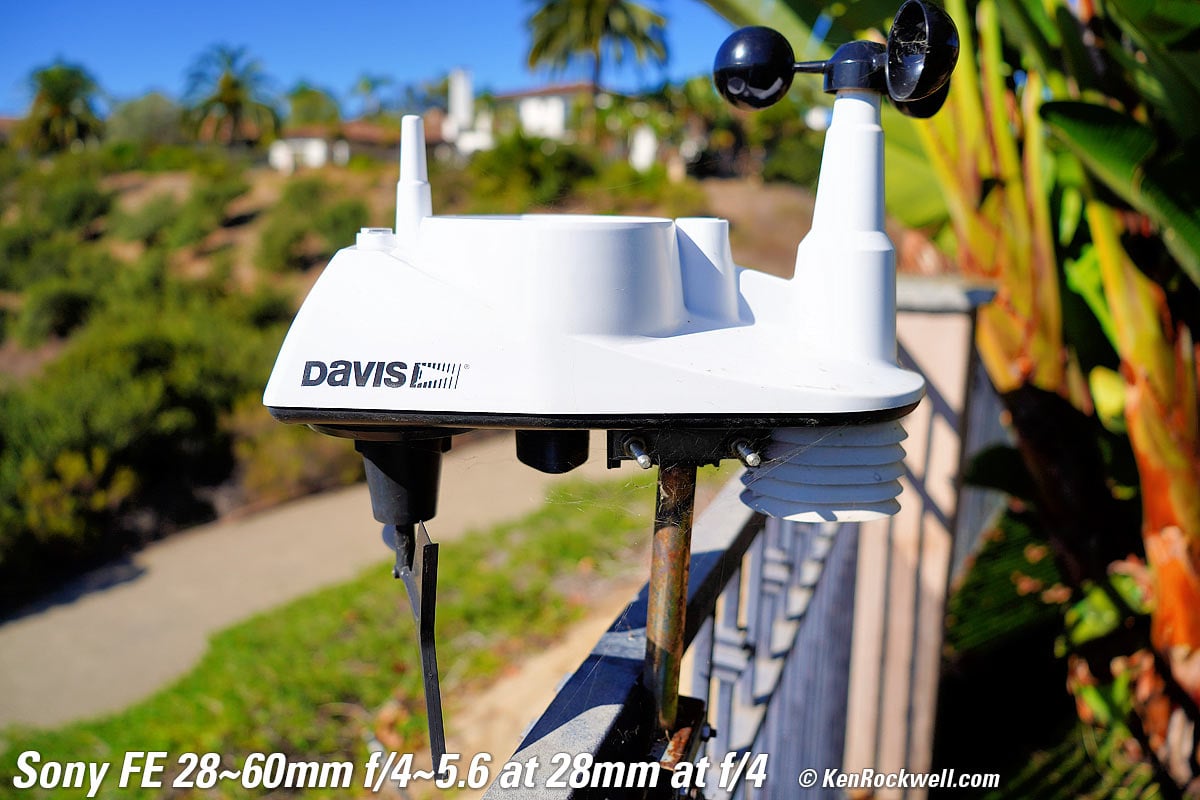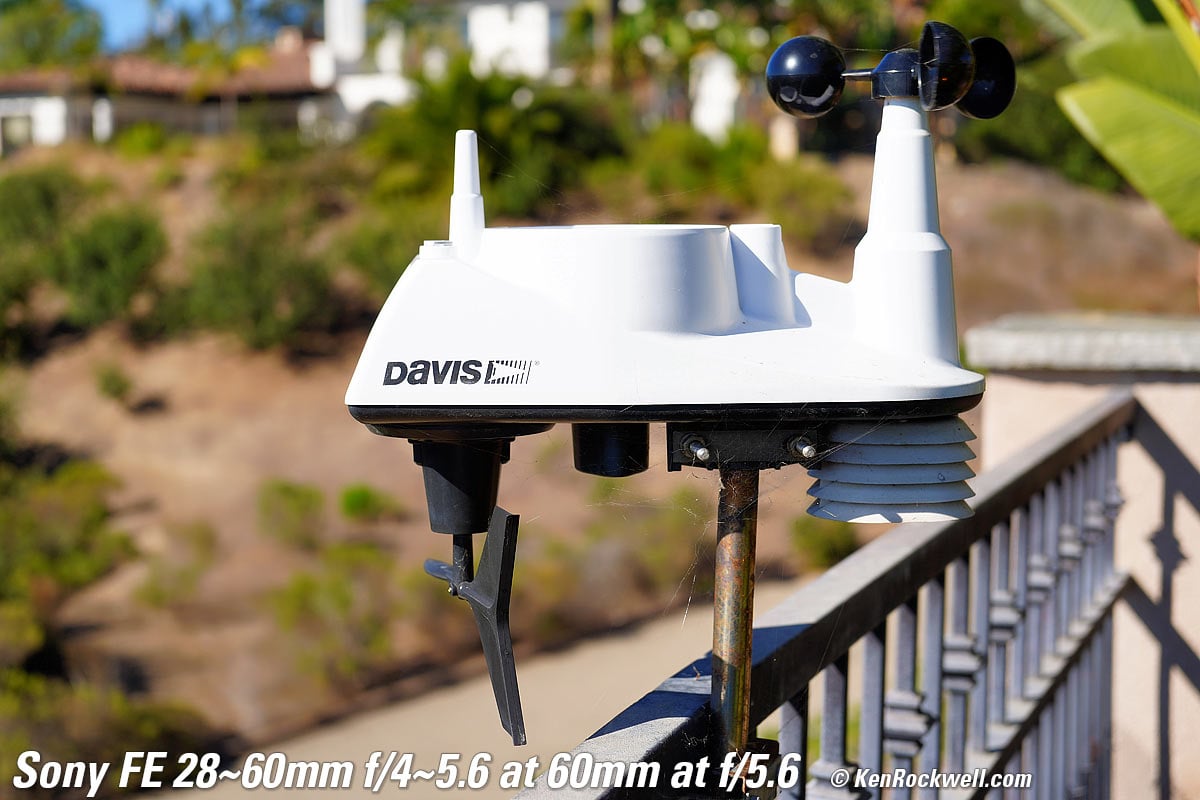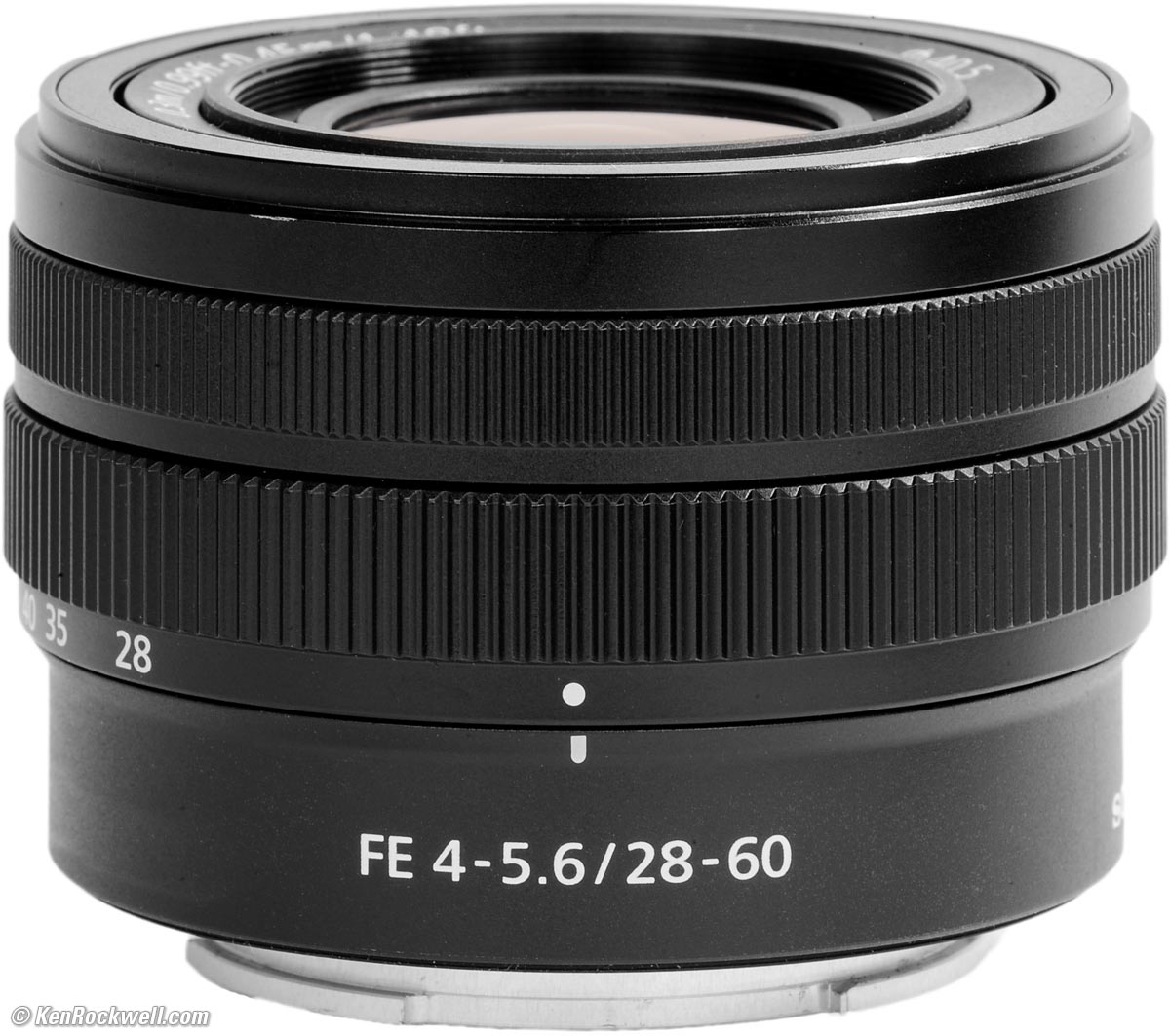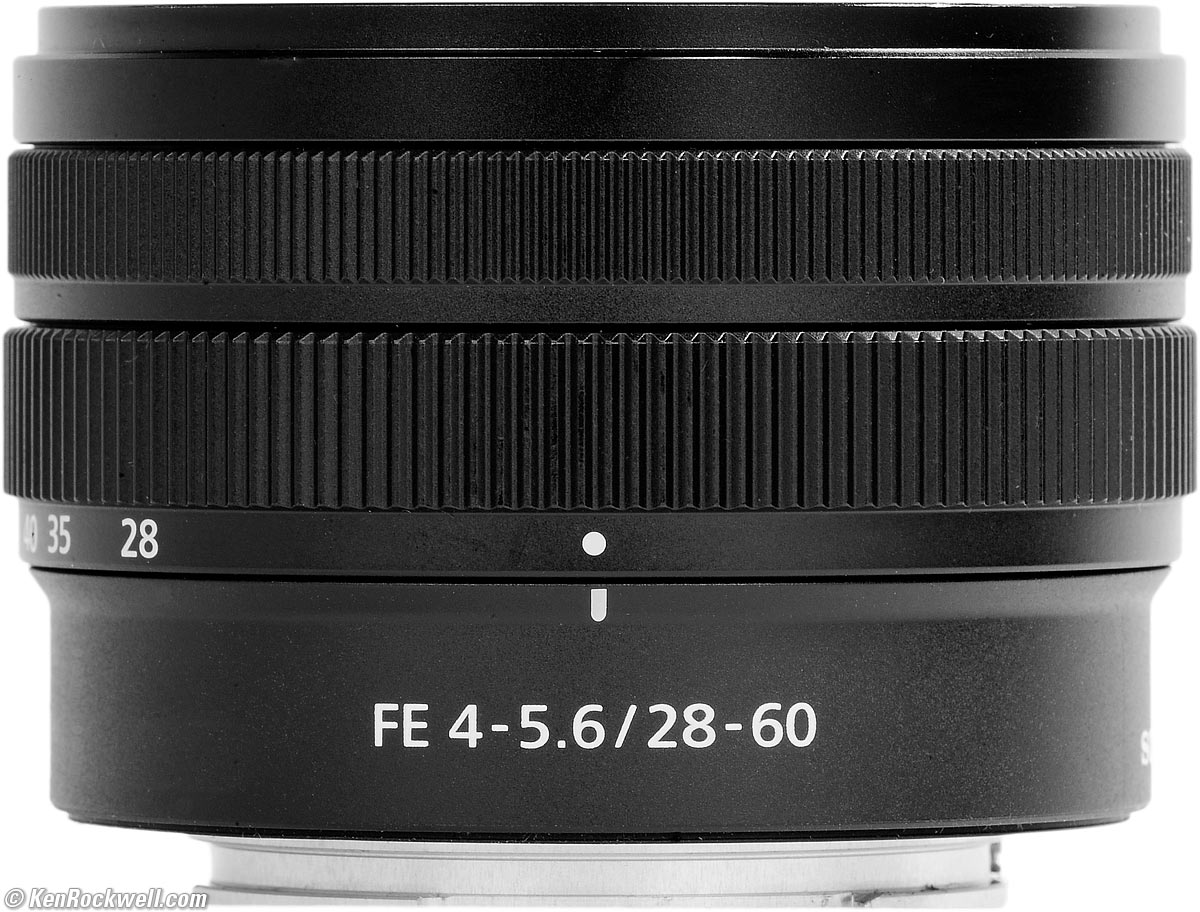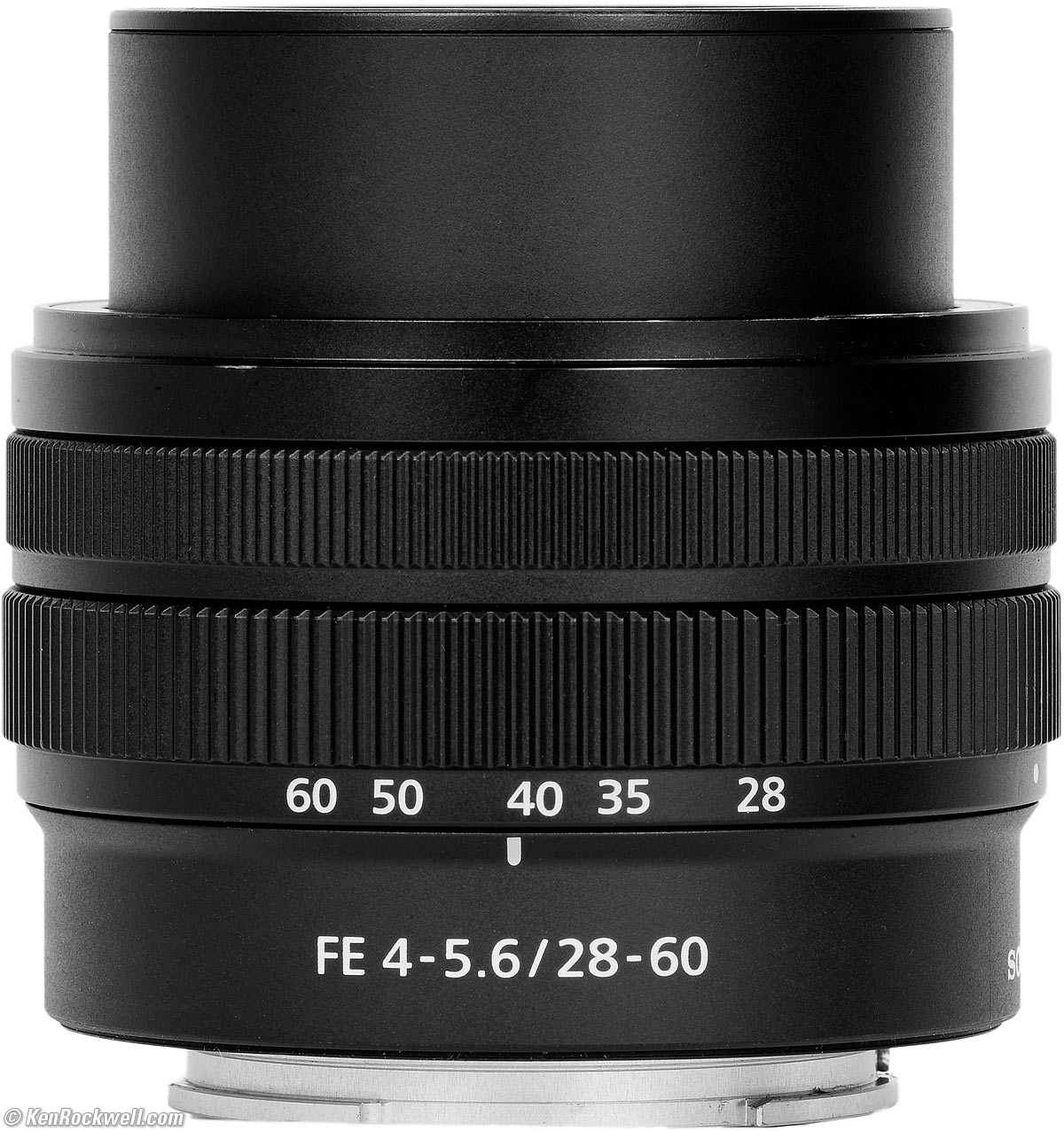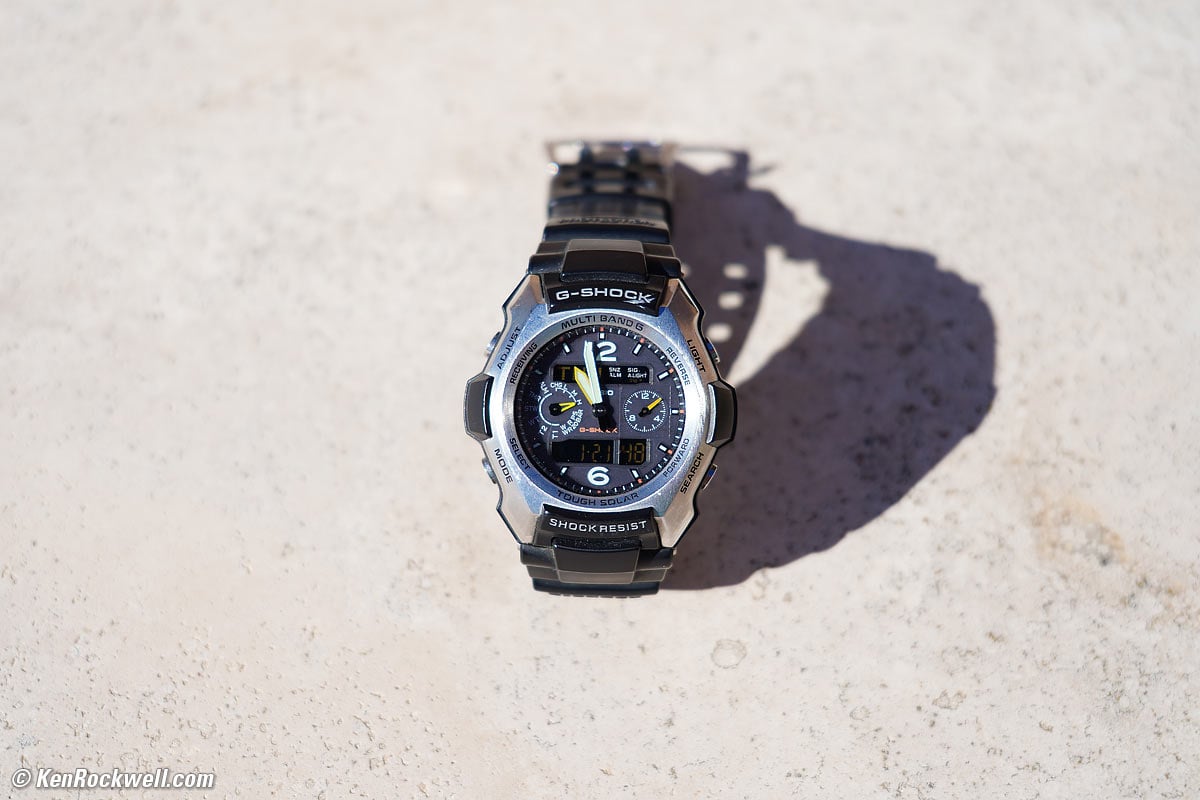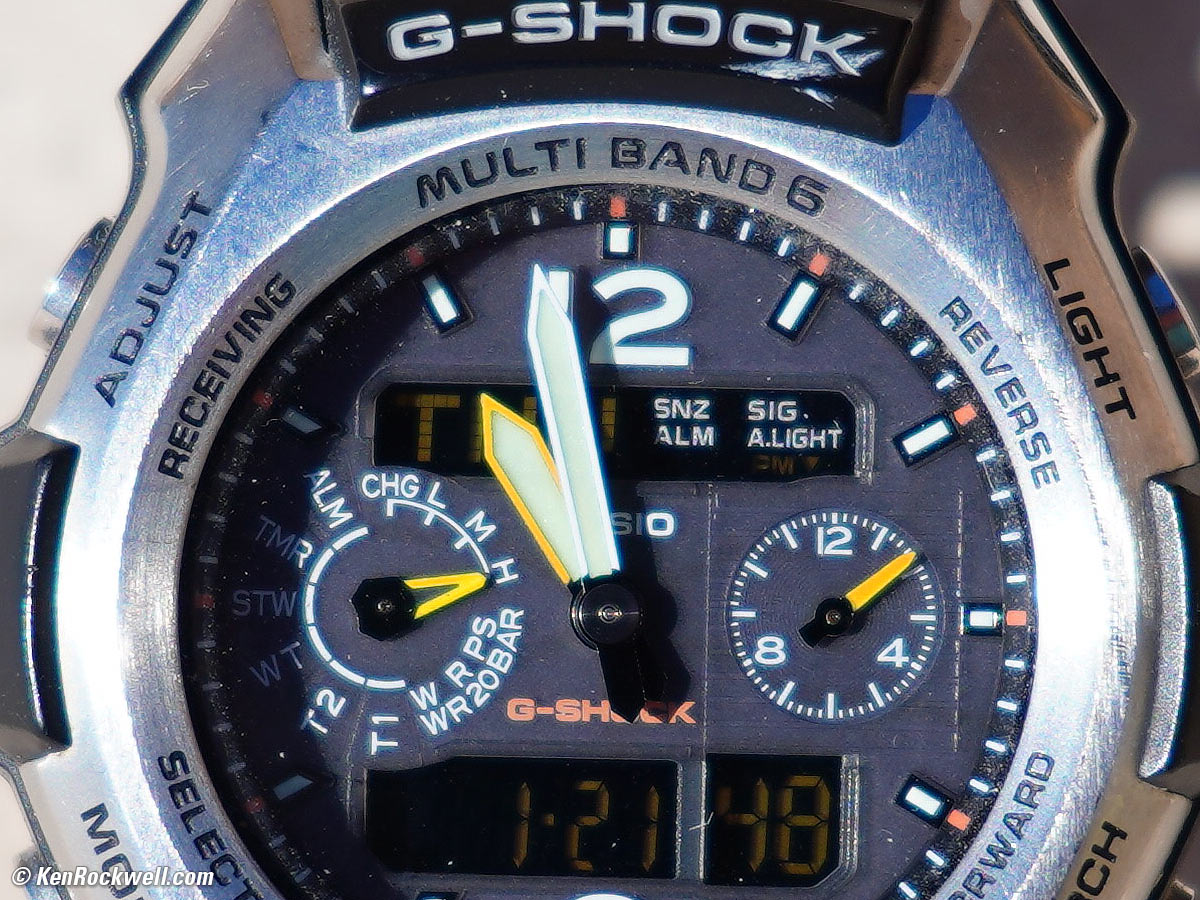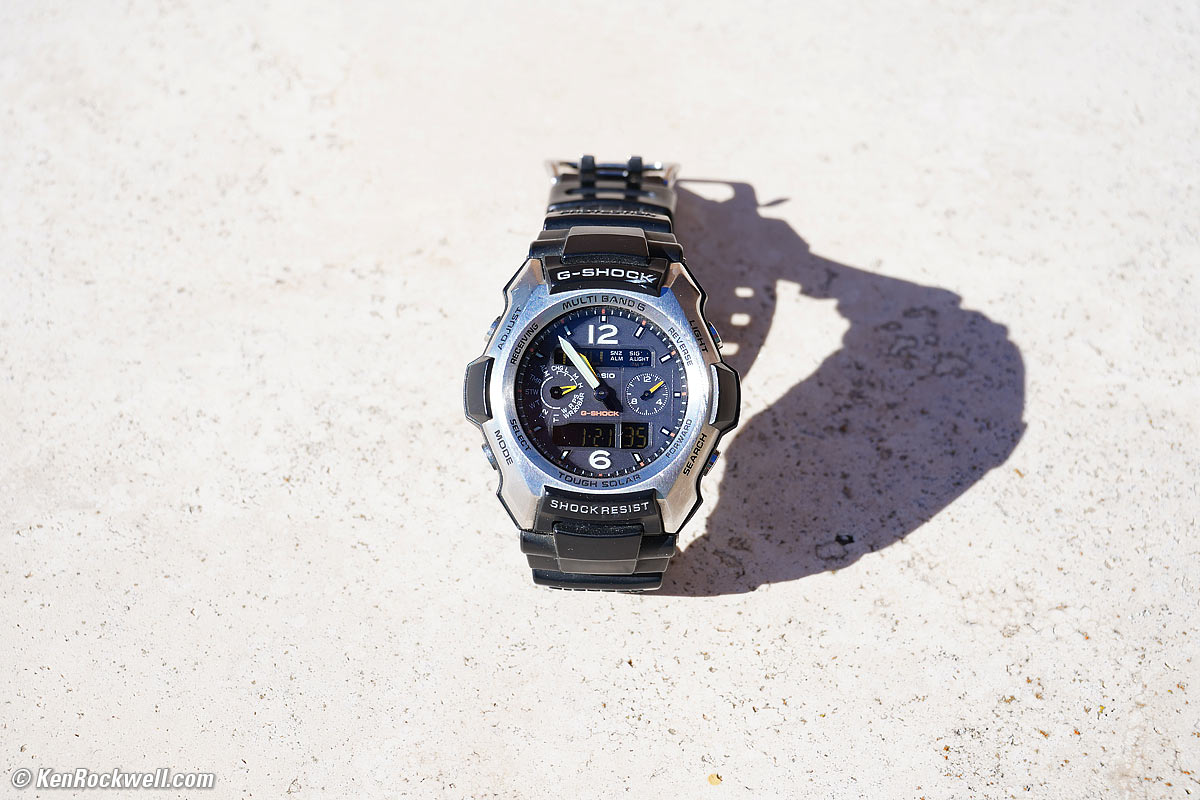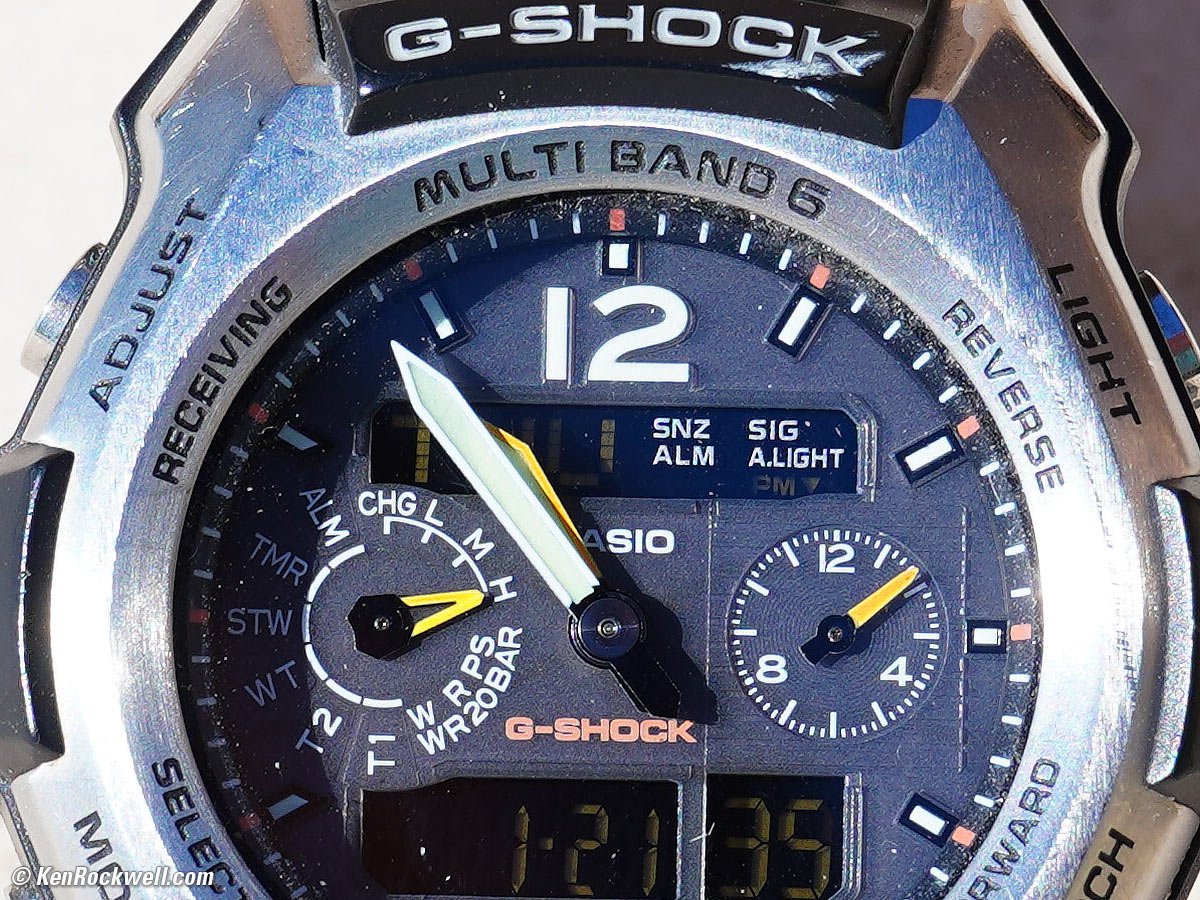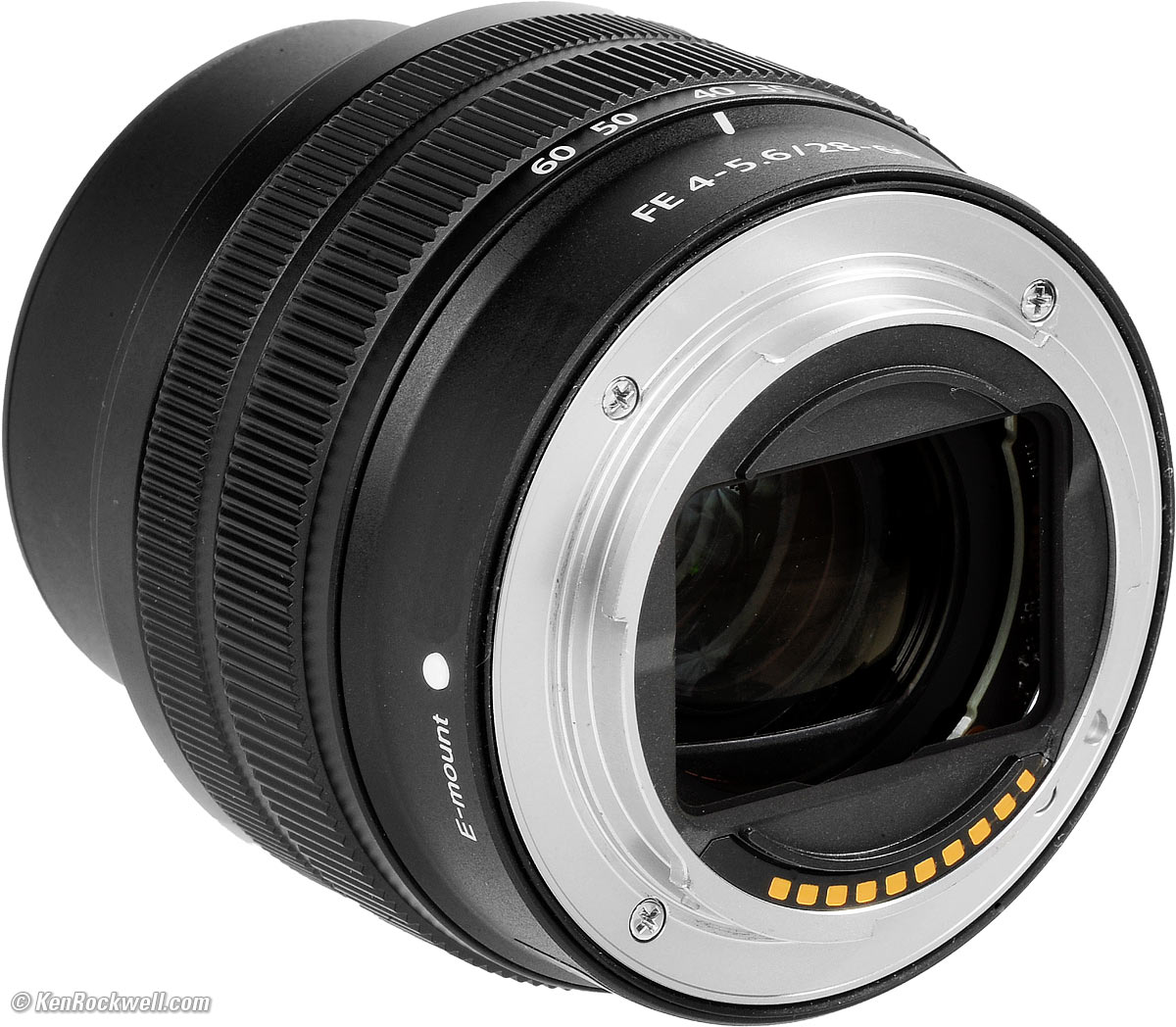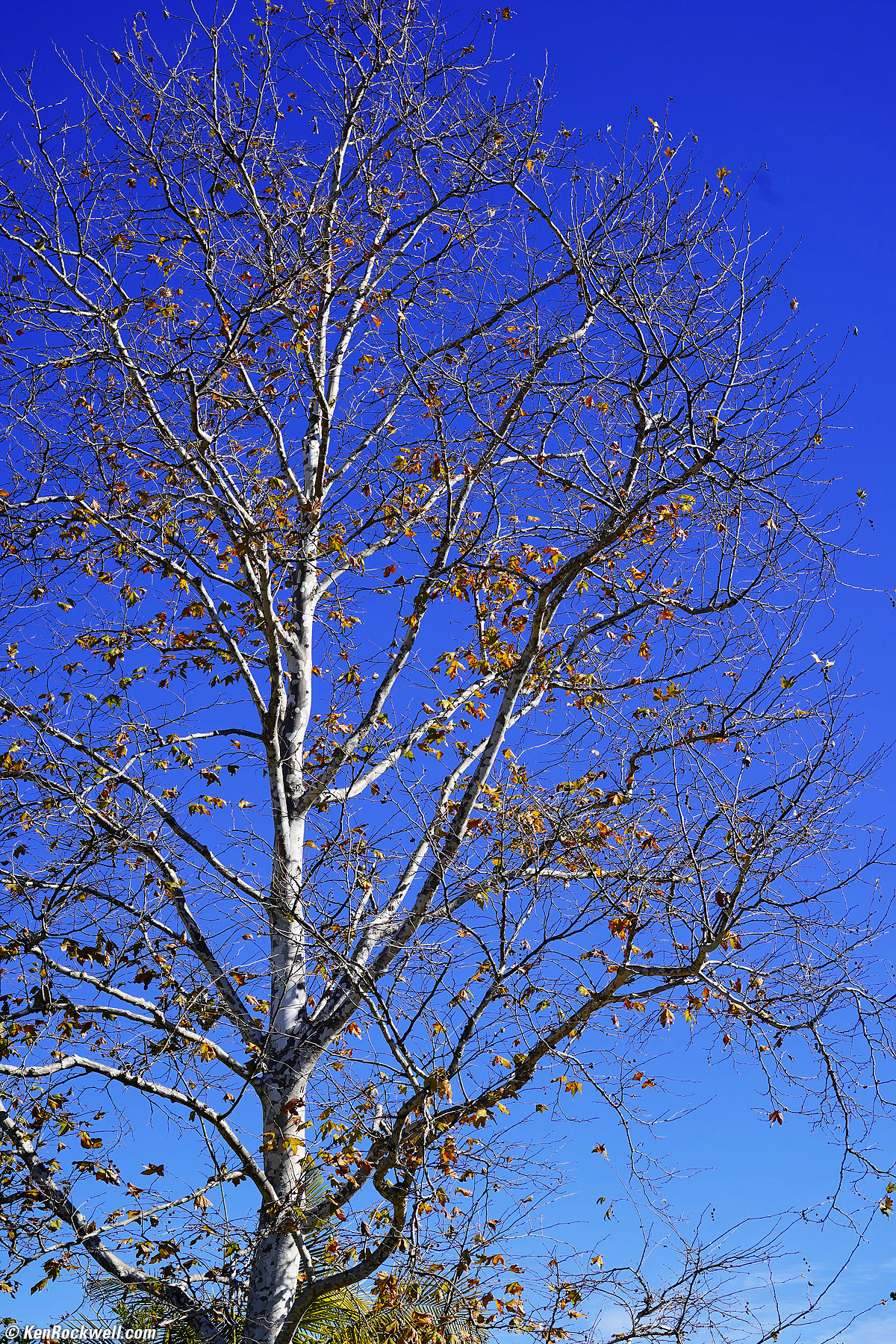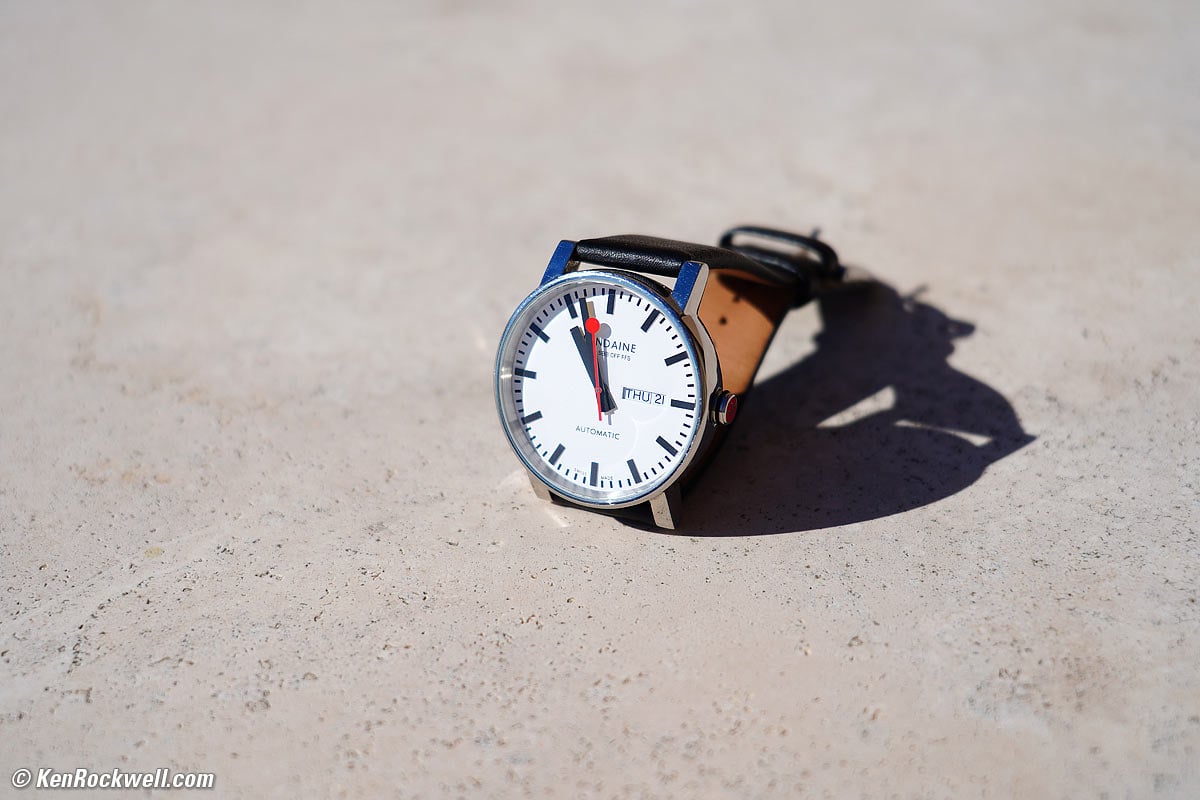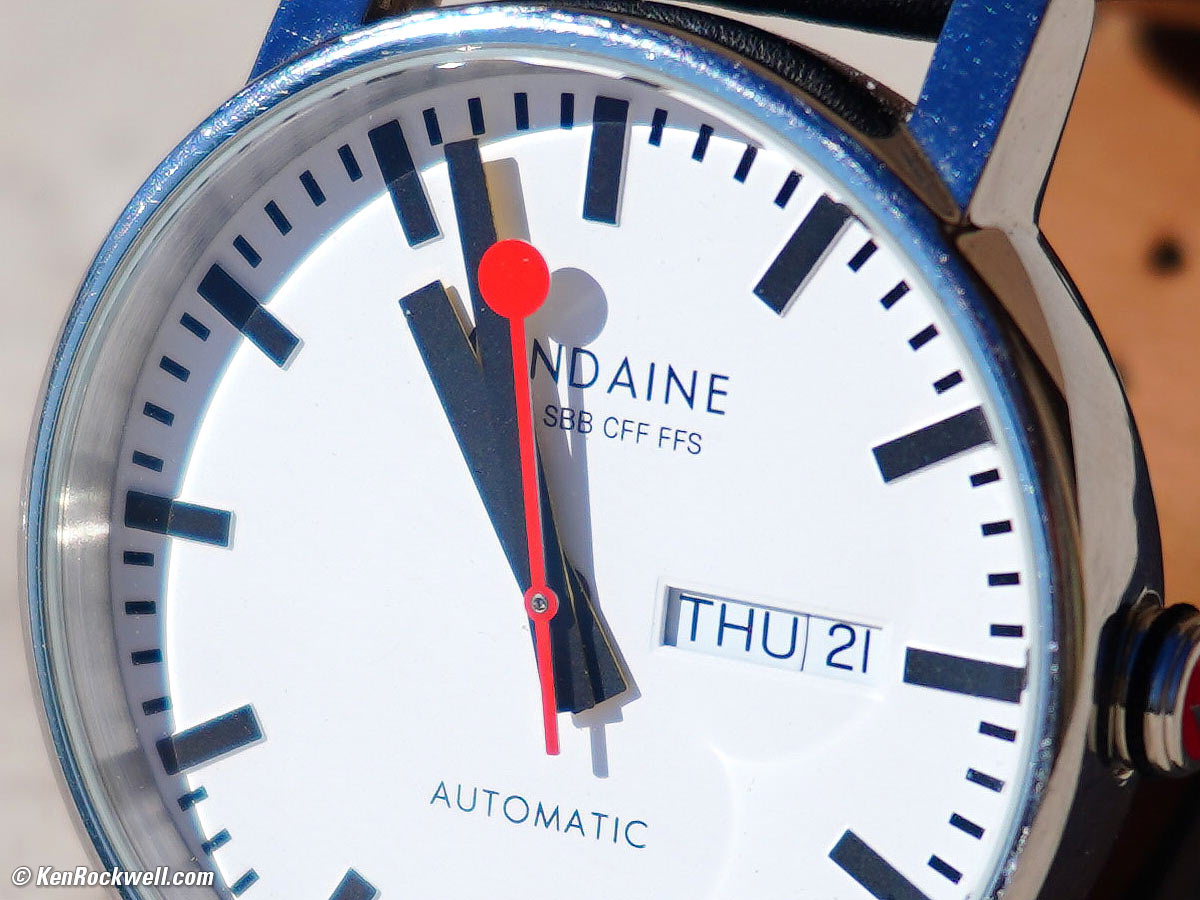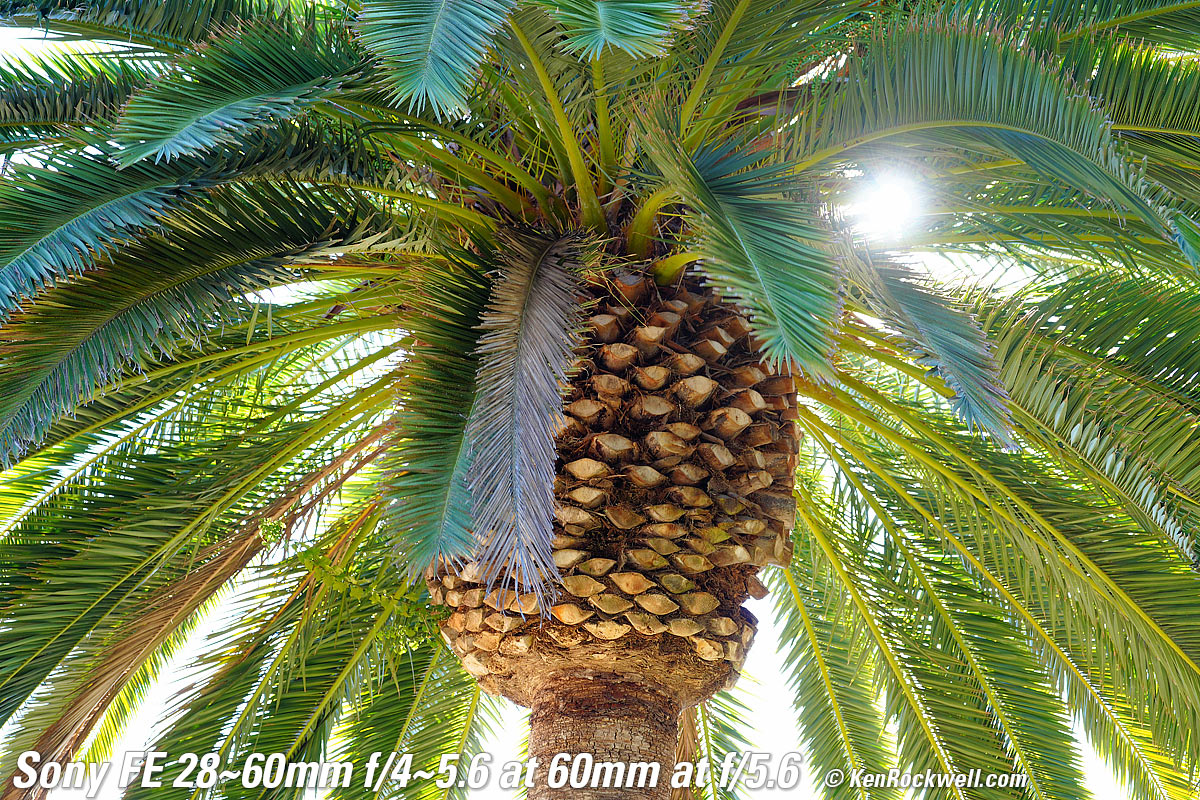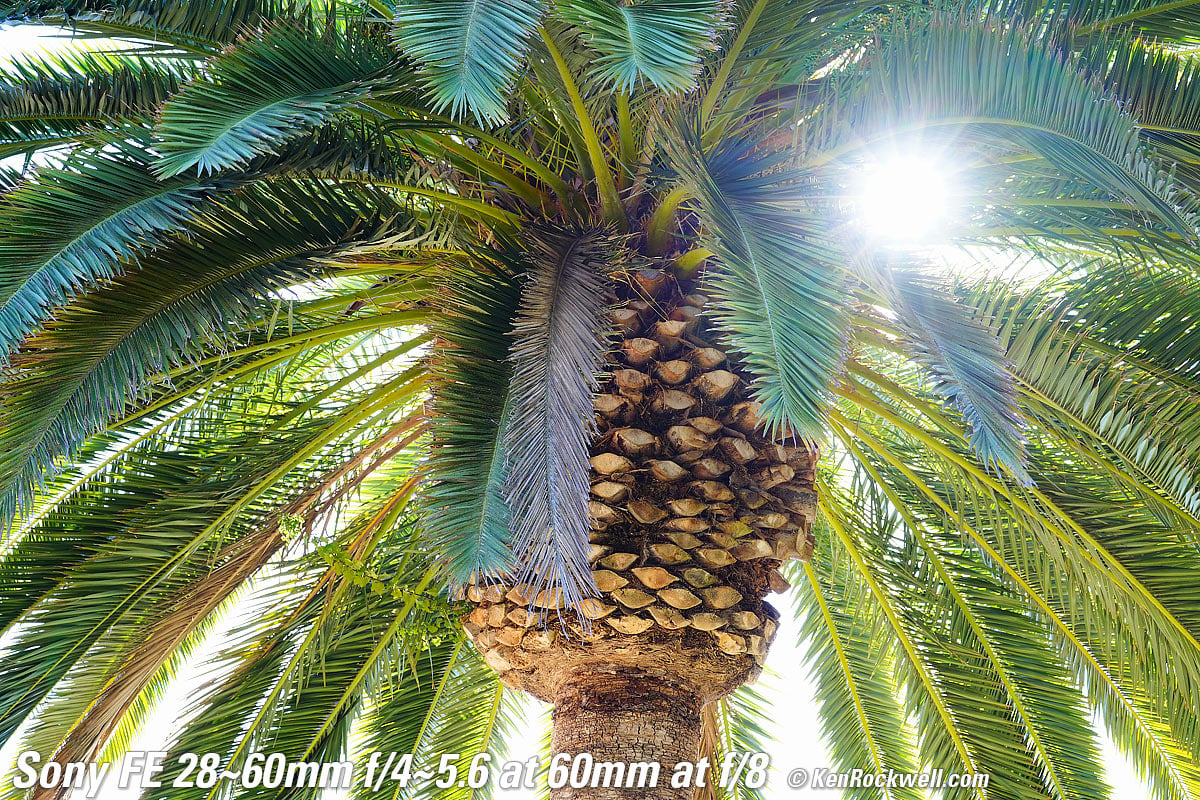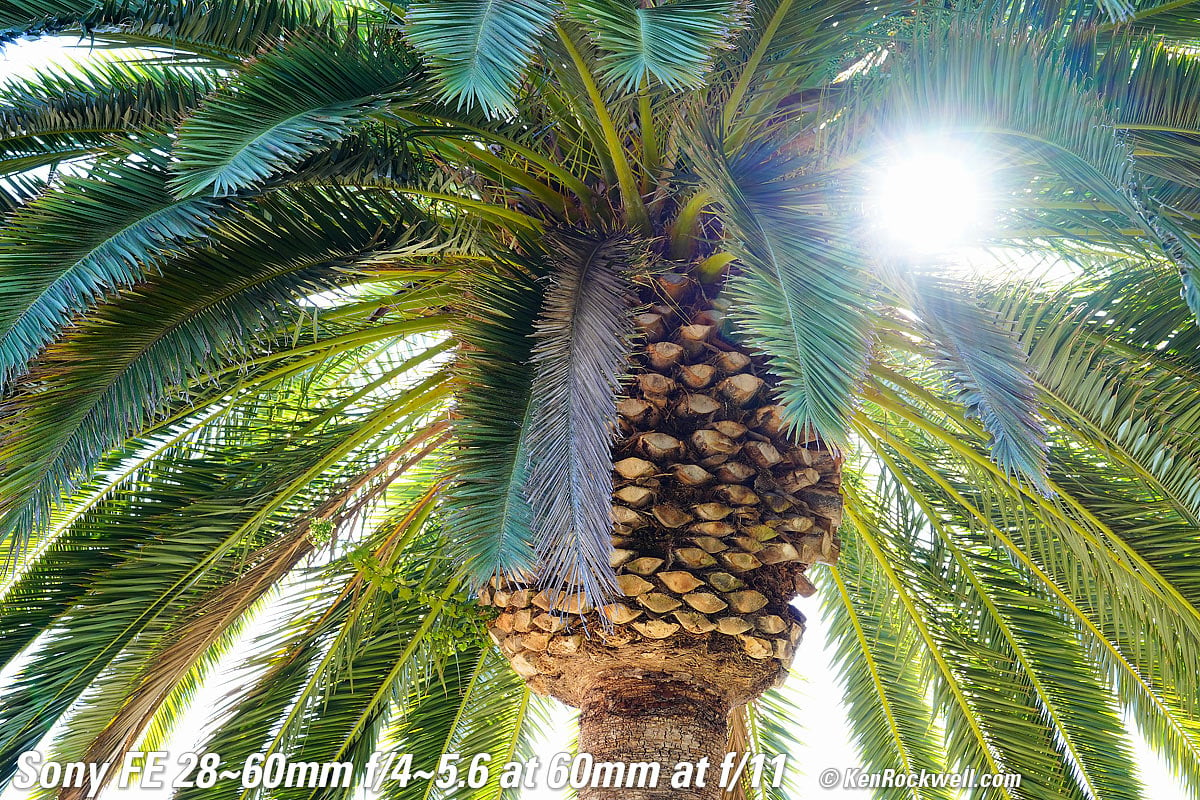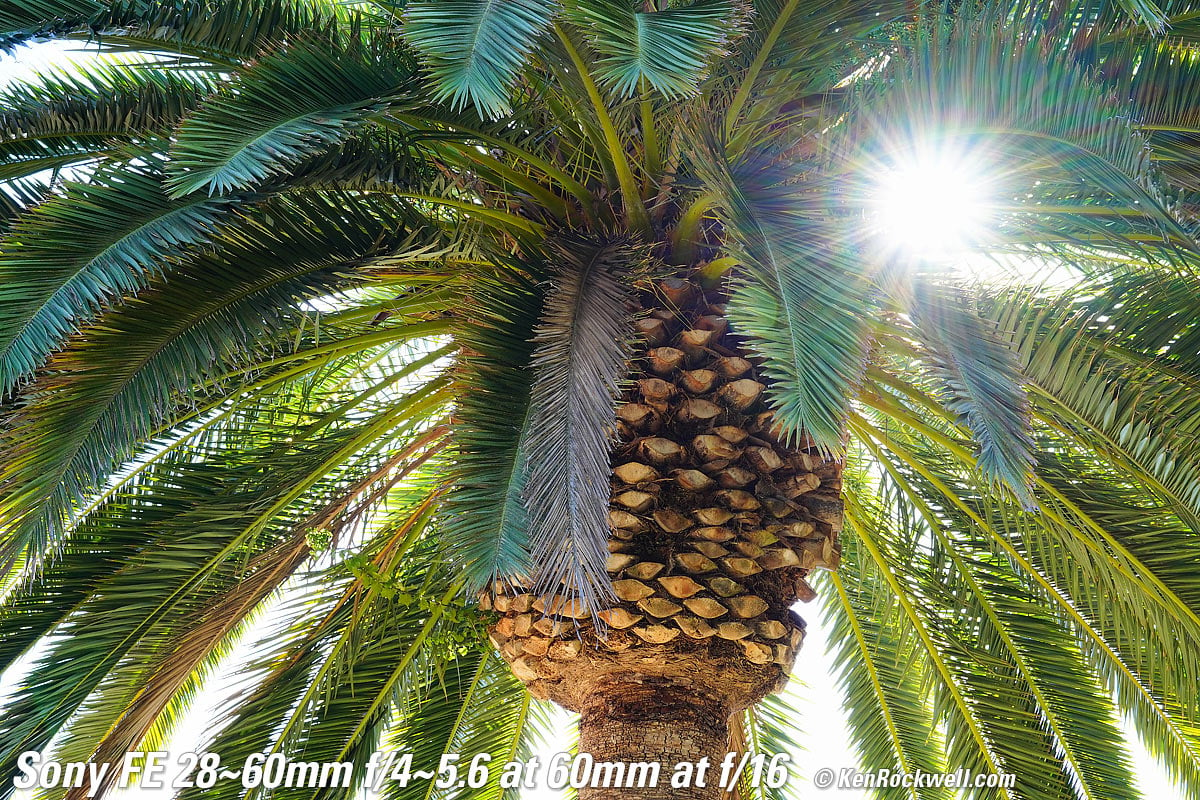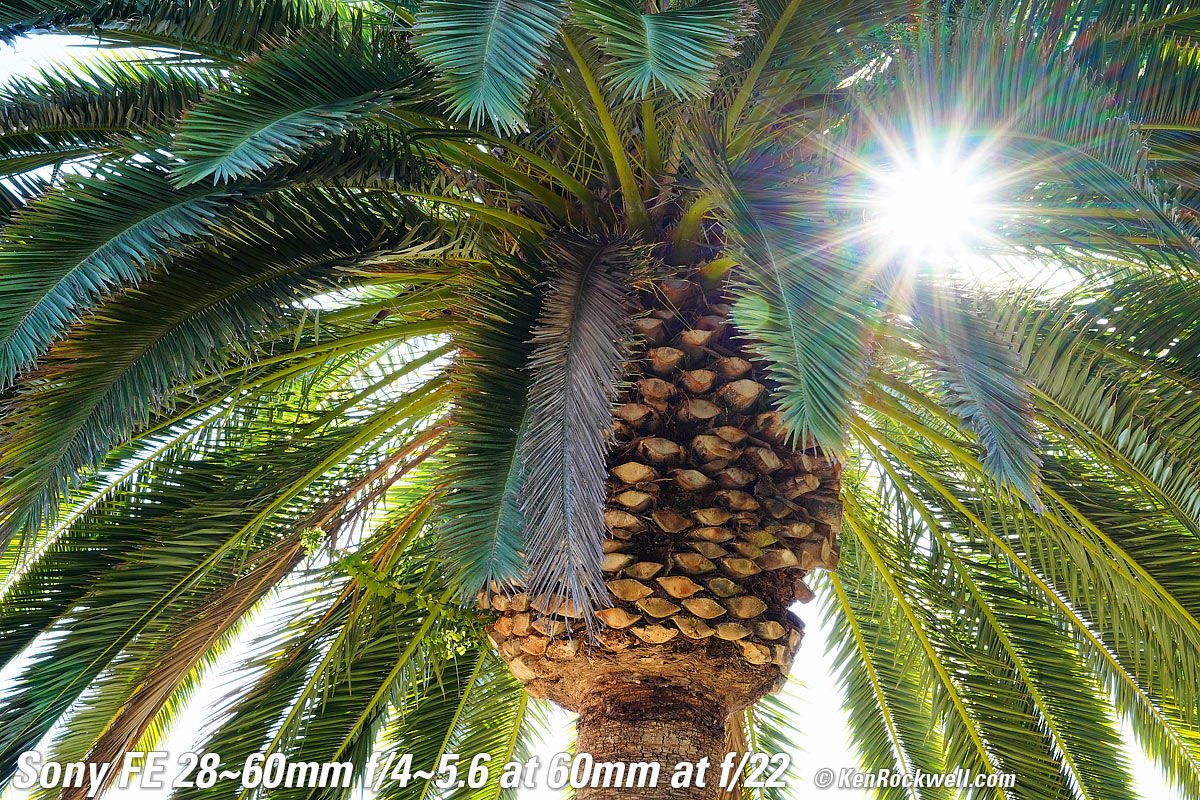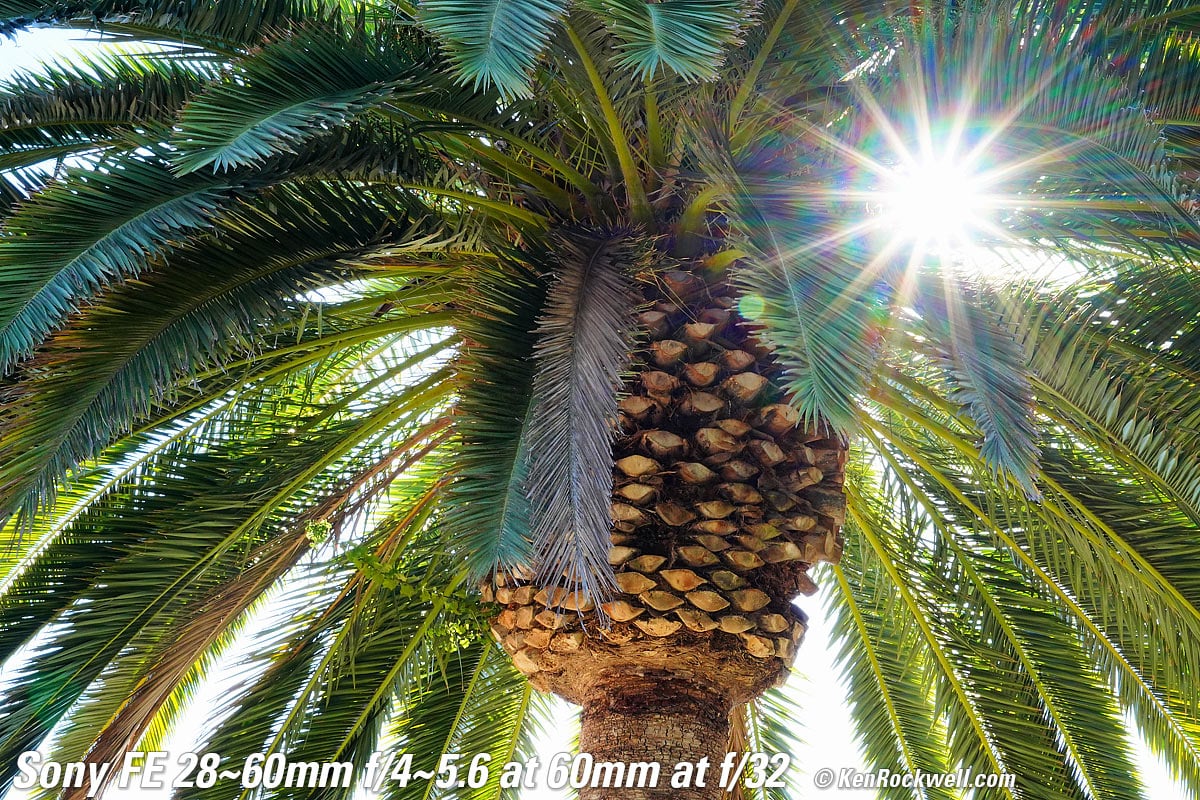Sony 28-60mm
f/4~5.6 FE Full-Frame (2020‑)
Sample Images Intro Compatibility
Sony FE 28-60mm f/4-5.6 (40.5mm filters, 5.9 oz./166g, 1-1.5'/0.3-0.45m close focus, $498). bigger. I'd get mine at Adorama, at Amazon, at B&H or at Crutchfield, or eventually used at eBay if you know How to Win at eBay.
This all-content, junk-free website's biggest source of support is when you use those or any of these links to approved sources when you get anything, regardless of the country in which you live. Thanks for helping me help you! Ken.
January 2021 Better Pictures Sony Sony Lenses Zeiss Nikon Canon Fuji LEICA All Reviews
Sony vs. Nikon vs. Canon Full-Frame
Sample Images top
Sample Images Intro Compatibility
These are just snapshots and there are many more throughout the review; my real work is in my Gallery.
Sunset, Torrey Pines, 5:08 PM, 18 January 2021. Tightly cropped from Sony A7C, Sony FE 28-60mm at 60mm at f/8 at 1/50 at Auto ISO 200 (LV 11.6), Perfectly Clear. bigger or camera-original © JPG file. If I printed the whole image at the same magnification as this crop, the complete image would be three times as big as you see here.
I deliberately underexposed so I wouldn't lose color saturation in the brilliant orange dot of the sun, knowing I'd bring up the rest of the dark image in Perfectly Clear as I've shown here. JPGs have loads of information allowing me to bring back shadow detail like this.
Angry Sunset (27 MPH westerly winds), Torrey Pines, 4:57 PM, Monday, 25 January 2021. Sony A7C, Sony FE 28-60mm at 28mm at f/8 at 1/250 at Auto ISO 100 with -0.7 stops exposure compensation (LV 14.0), Perfectly Clear. bigger, full-resolution or camera-original © JPG file.
Again I deliberately underexposed with -0.7 stops exposure compensation so I wouldn't lose color saturation in the brilliant orange areas, knowing I'd bring up the rest of the dark image in Perfectly Clear as I've shown here.
Moon in Angry Sky as seen from Torrey Pines, 5:07 PM, Monday, 25 January 2021. Sony A7C, Sony FE 28-60mm at 60mm at f/8 at 1/125 at Auto ISO 100 with -0.7 stops exposure compensation (LV 13.0), Perfectly Clear. bigger, full-resolution or camera-original © JPG file.
Again I deliberately underexposed with -0.7 stops exposure compensation so I wouldn't lose detail in the moon or color saturation in the brilliant orange areas, knowing I'd bring up the rest of the dark image in Perfectly Clear as I've shown here.
Introduction top
Sample Images Intro Compatibility
|
I buy only from these approved sources. I can't vouch for ads below. |
This Sony FE 28-60mm is an all-plastic Chinese lens with an aluminum mount. It has no internal stabilization, and it is weightless, has no distortion as shot, is very sharp as you can see, and it easily collapses for storage.
I'd get my 28-60mm at Adorama, at Amazon, at B&H or at Crutchfield, or eventually used at eBay if you know How to Win at eBay.
New intro top
 Tiny, weightless plastic lens that collapses for carrying.
Tiny, weightless plastic lens that collapses for carrying.
Good intro top
 Sharp, small, tiny and inexpensive. For what more could you ask?
Sharp, small, tiny and inexpensive. For what more could you ask?
 Easily collapses for carrying.
Easily collapses for carrying.
 Good Sunstars.
Good Sunstars.
 Good Macro performance.
Good Macro performance.
 No visible Distortion or Falloff.
No visible Distortion or Falloff.
Bad intro top
 Offshored to China; not made domestically in Japan.
Offshored to China; not made domestically in Japan.
Missing intro top
 No AF/MF switch.
No AF/MF switch.
 No Image Stabilization. While in-camera stabilization is better than nothing, optical stabilization would work much better.
No Image Stabilization. While in-camera stabilization is better than nothing, optical stabilization would work much better.
 No IS switch for in-camera Image Stabilization.
No IS switch for in-camera Image Stabilization.
Sony FE 28-60mm. bigger.
Compatibility top
Sample Images Intro Compatibility
I'd get my 28-60mm at Adorama, at Amazon, at B&H or at Crutchfield, or eventually used at eBay if you know How to Win at eBay.
This works on all Sony E-mount cameras, full-frame and crop-sensor. This includes all the variations of NEX, A9-, A7-, A6xxx and A5xxx series cameras.
It will not work on any Sony A-mount DSLR or any Minolta MAXXUM 35mm SLR of any kind. Those use the old A mount which was actually the Minolta MAXXUM mount from 1986.
Specifications top
Sample Images Intro Compatibility
I'd get my 28-60mm at Adorama, at Amazon, at B&H or at Crutchfield, or eventually used at eBay if you know How to Win at eBay.
Name specifications top
Sony calls this the FE 28–60 mm F4–5.6:
FE: Full-frame coverage, E-mount.
Sony's model number: SEL2860.
Optics specifications top
Sony FE 28-60mm internal optical construction. Aspherical elements. bigger.
8 elements in 7 groups.
Three Aspherical elements.
The front group collapses for storage (it's shown erect here), and the front group moves in and out as zoomed.
Autofocus specifications top
No external movement as focussed, so no air or dust is sucked in.
Filters specifications top
Plastic 40.5mm threads.
Diaphragm specifications top
Sony FE 28-60mm. bigger.
7 rounded blades.
Electronically actuated.
Stops down to f/22 ~ f/32.
Focal Length specifications top
28-60mm.
When used on an APS-C camera, it sees the same angles of view as a 42-90mm lens sees when used on a full-frame or 35mm camera.
See also Crop Factor.
Angles of View specifications top
Full Frame
75º ~ 40º diagonal.
APS-C
54º ~ 27º diagonal.
Focus Scale specifications top
No.
Infinity Focus Stop specifications top
No.
Depth of Field Scale specifications top
No.
Infrared Focus Index specifications top
No.
Close Focus specifications top
1 ~ 1.5 feet.
12 ~ 18 Inches.
0.3 ~ 0.45 meters.
Maximum Reproduction Ratio specifications top
1:6.2 (0.16 ×).
Reproduction Ratio Scale specifications top
No.
Image Stabilizer specifications top
NONE.
Front Cap specifications top
Plastic 40.5mm cap.
Hood specifications top
None.
Case specifications top
None.
Size specifications top
2.62" ø maximum diameter × 1.77" extension from flange.
66.6 mm ø maximum diameter × 45 mm extension from flange when collapsed. Longer when shooting.
Weight specifications top
5.870 oz. (166.4g) actual measured weight.
Rated 5.9 (167g).
Announced specifications top
15 September 2020.
Included specifications top
Lens, caps, and that's it.
Sony's Model Number specifications top
SEL2860.
Quality specifications top
Sony FE 28-60mm. bigger.
Made in China.
Price, U. S. A. specifications top
$498, January 2021.
Performance top
Sample Images Intro Compatibility
Overall Autofocus Manual Focus Breathing Bokeh
Distortion Ergonomics Falloff Filters, use with
Flare & Ghosts Lateral Color Fringes
Lens Corrections Macro Min & Max Apertures
Mechanics Sharpness Spherochromatism
I'd get my 28-60mm at Adorama, at Amazon, at B&H or at Crutchfield, or eventually used at eBay if you know How to Win at eBay.
Overall performance top
The 28-60/2.8 is a tiny lens that performs extremely well. I expect this, as it has a limited zoom range and slow speed, making it easy to design a sharp lens.
Autofocus performance top
Autofocus is immediate. Your camera and conditions will be more of a limitation than this lens.
Manual Focus performance top
Manual focusing is entirely electronic; the manual focus ring isn't connected to anything other than a digital encoder.
Focus Breathing performance top
Focus breathing is the image changing size as focused in and out. It's important to cinematographers that the image not breathe because it looks funny if the image changes size as focus gets pulled back and forth between actors. If the lens does this, the image "breathes" by growing and contracting slightly as the dialog goes back and forth.
This 28-80mm has little to no breathing. The image from this 28-60 gets very slightly larger as focussed more closely at middle and long zoom settings, and no breathing at all at 28mm.
Bokeh performance top
Bokeh, the feel, character or quality of out-of-focus areas as opposed to how far out of focus they are, doesn't matter much for a lens this slow because everything is almost always pretty much in focus anyway.
This said, bokeh is good to neutral. Sony's doing their homework; it looks great if you care.
Here are photos from headshot distance wide-open:
Made-in-U. S. A. Davis 6250 weather station, 21 January 2021. Sony A7C, Sony FE 28-60mm at 28mm at f/4 at 1/1,250 at Auto ISO 100 with +0.7 stops exposure compensation (LV 14.3). bigger or camera-original © file.
Made-in-U. S. A. Davis 6250 weather station, 21 January 2021. Sony A7C, Sony FE 28-60mm at 60mm at f/5.6 at 1/500 at Auto ISO 100 with +0.7 stops exposure compensation (LV 14.9). bigger or camera-original © file.
As always, if you want to throw the background as far out of focus as possible, shoot at 60mm at f/5.6 and get as close as possible.
Distortion performance top
The Sony FE 28-60mm has no visible distortion, shot as JPG with distortion correction ON. At least on my Sony A7C, I can't turn off the automatic correction, it's always ON.
For more critical scientific use, use these corrections in Photoshop's lens correction filter to correct the slight barrel distortion at wide settings with JPG images. No, I have no idea why my A7C doesn't correct the distortion completely.
If you shoot raw and use non-manufacturer software to process the raw data into images, that software is unlikely to be able to correct the distortion as is done in-camera as JPGs, so you may be on your own.
These aren't facts or specifications, they are the results of my research that requires hours of photography and calculations on the resulting data.
On Full-Frame and 35mm at 30' (10m) |
Correction factor to use with images made with correction ON in A7C |
28mm |
+0.70* |
40mm |
+0.30 |
60mm |
±0.00 |
© 2021 KenRockwell.com. All rights reserved.
* Some slight waviness remains after this correction.
Ergonomics performance top
Collapsed. bigger. |
Ready to shoot at 42mm. bigger. |
Collapsed. bigger. |
Ready to shoot at 42mm. bigger. |
It's a tiny lens that handles well. The front ring is an electronic focus ring and the rear ring is a traditional mechanical zoom control.
Just turn the zoom past 28mm to the dot to collapse, and vice-versa to erect for shooting. It's perfect; there are no locks but the shooting and collapsed positions have just the right detents to keep them all clear. Bravo!
The lens-mounting index is a microscopic white ball which is just about invisible and hard to feel. Poo!
Falloff performance top
Falloff isn't visible, so long as you leave the default automatic correction ON.
I've greatly exaggerated the falloff by shooting a gray field and placing these on a gray background; it will not look this bad in actual photos of real things:
Sony 28-60mm Falloff on Full-Frame at infinity, correction at default of ON:
© 2021 KenRockwell.com. All rights reserved. |
If you go out of your way to turn off falloff correction and then go looking for it, you can see some at 28mm wide-open:
Sony 28-60mm Falloff on Full-Frame at infinity, correction deliberately turned OFF:
© 2021 KenRockwell.com. All rights reserved. |
Filters, use with performance top
There's no need for thin 40.5mm filters.
Even thick ones work fine, but I wouldn't expect to be able to stack them at the 28mm end on full-frame.
Flare & Ghosts performance top
Flare and ghosts are well controlled.
See examples at Sunstars.
Lateral Color Fringes performance top
There are no color fringes when shot as JPG with the default Chromatic Aberration Correction left ON.
if you go out of your way to turn this OFF (or shoot raw and then use non-manufacturer software to process that data into images) then there is just the tiniest bit of green/magenta fringing at 28mm, and essentially none at 40mm and 60mm.
Lens Corrections performance top
My Sony A7C corrects for any or all of Falloff ("Shading Comp."), Lateral Color ("Chromatic Aberratio…") and Distortion (Distortion Comp.).
By default, they are all ON ("Auto).
On my Sony A7C, I can turn the Falloff ("Shading") and Lateral Color ("Chromatic Aberratio…") corrections ON (Auto) or OFF, but the Distortion (Distortion Comp.) correction is always ON (Auto). In other words, My A7C won't let me turn off distortion correction.
These corrections apply to images shot as JPG, as I always shoot. If you shoot raw data, the software you use to turn the raw data into an image may or may not apply any of these corrections in the process. Sony's software might, but non-Sony software probably won't. I never shoot raw.
Macro Performance performance top
Macro gets a little closer than most lenses, and it's pretty sharp. Great!
At 60mm at f/5.6
Casio G-Shock Solar Atomic Watch at close-focus distance, 21 January 2021. bigger or camera-original © file.
It has some residual spherical aberration and spherochromatism that makes it a bit less sharp wide-open here at f/5.6:
1,200 × 900 pixel crop from above. bigger or camera-original © file.
If this 1,200 × 900 pixel crop is about 3" (7.5cm) wide on your screen, then the complete image printed at this same large magnification would be about 10 × 15" (25 × 38cm).
If this 1,200 × 900 pixel crop is about 6" (15cm) wide on your screen, then the complete image printed at this same extreme magnification would be about 20 × 30" (50 × 75cm).
If this 1,200 × 900 pixel crop is about 12" (30cm) wide on your screen, then the complete image printed at this same insanely high magnification would be about 40 × 60" (1 × 1.5 meters).
At 60mm at f/11
It's even sharper at f/11, which makes the spherical aberration and spherochromatism go away:
Casio G-Shock Solar Atomic Watch at close-focus distance, 21 January 2021. bigger or camera-original © file.
1,200 × 900 pixel crop from above. bigger or camera-original © file.
If this 1,200 × 900 pixel crop is about 3" (7.5cm) wide on your screen, then the complete image printed at this same large magnification would be about 10 × 15" (25 × 38cm).
If this 1,200 × 900 pixel crop is about 6" (15cm) wide on your screen, then the complete image printed at this same extreme magnification would be about 20 × 30" (50 × 75cm).
If this 1,200 × 900 pixel crop is about 12" (30cm) wide on your screen, then the complete image printed at this same insanely high magnification would be about 40 × 60" (1 × 1.5 meters).
Minimum & Maximum Apertures performance top
Maximum Aperture |
Minimum Aperture |
|
| 28mm | f/4 |
f/22 |
| 35mm | f/4.5 |
f/25 |
| 40mm | f/5 |
f/29 |
| 50mm | f/5.6 |
f/32 |
| 60mm | f/5.6 |
f/32 |
Mechanical Quality performance top
Sony FE 28-60mm. bigger.
This is an all-plastic Chinese lens. Except that it has glass glass and a lightweight aluminum mount, it's as dinky as we get in the developed world.
Front Bumper
None.
Filter Threads
Plastic.
Hood Bayonet Mount
NONE.
Front Barrel
Plastic.
Trim Ring in front of Focus Ring
Black-anodized aluminum.
Focus Ring
Hard plastic.
Zoom Ring
Hard plastic.
Rear Barrel
Plastic.
Identity
Printed around the front of the lens.
Printed on the top barrel of the lens.
Also printed on a sticker on the bottom of the lens.
Internals
Seem like all plastic, except for the glass elements.
Dust Gasket at Mount
Yes.
Mount
Aluminum.
This won't last anywhere near as long as brass, but it will last a lot longer than plastic, and won't break, either.
Aluminum is entirely appropriate for this lens which rarely gets mounted or unmounted, and for which saving weight is important. This is a brilliant upgrade from plastic, bravo!
Markings
Just printed.
Serial Number
Sony FE 28-60mm. bigger.
Printed on a sticker on the bottom of the barrel.
This isn't acceptable for a serious lens, but for a throwaway like this it's probably OK. The problem is that you don't want the serial number to wear off from usage before you throw the lens away, and for a lens like this which usually doesn't see all-day, every-day heavy usage like a pro lens, you should be OK.
Date Code
None found.
Noises When Shaken
Moderately loud clunking from the uncaged focussing group flopping all around inside the lens. These don't cage or lock-down when the power is off.
Made in
Made in China.
Sharpness performance top
Lens sharpness has nothing to do with picture sharpness; every lens made in the past 100 years is more than sharp enough to make super-sharp pictures if you know what you're doing. The only limitation to picture sharpness is your skill as a photographer. It's the least talented who spend the most time worrying about lens sharpness and blame crummy pictures on their equipment rather than themselves. Skilled photographers make great images with whatever camera is in their hands; I've made some of my best images of all time with an irreparably broken camera! Most pixels are thrown away before you see them, but camera makers don't want you to know that.
If you're not getting ultra-sharp pictures with this, be sure not to shoot at f/16 or smaller where all lenses are softer due to diffraction, always shoot at ISO 100 or below because cameras become softer at ISO 200 and above, be sure everything is in perfect focus, set your camera's sharpening as you want it and be sure nothing is moving, either camera or subject. If you want to ensure a soft image with any lens, shoot at f/22 at ISO 1,600 in daylight of moving subjects at differing distances in the same image.
This lens is super-sharp used properly. It's not absolutely perfect in the far corners wide-open in the lab, but certainly more than sharp enough for me to be able to sell its images to major clients.
Here's a sharp shot of nothing:
Tree, 11:11 AM, Wednesday, 27 January 2021. Sony A7C, Sony FE 28-60mm at 57mm at f/8 at 1/320 at Auto ISO 100 (LV 14.3), Perfectly Clear. bigger, full-resolution or camera-original © JPG file.
Here are Sony's MTF charts at 10 cyc/mm and 30 cyc/mm, radial (solid) and tangential (dotted):
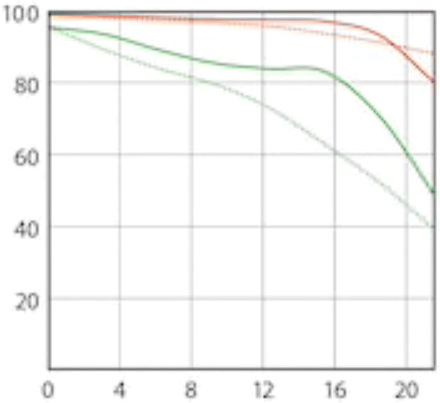 |
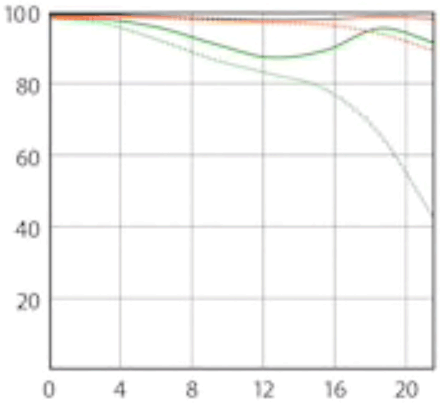 |
MTF at 28mm at f/4. |
MTF at 28mm at f/8. |
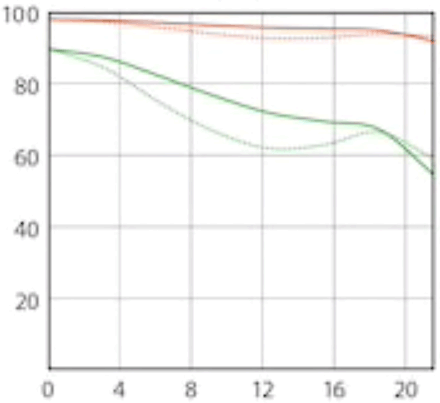 |
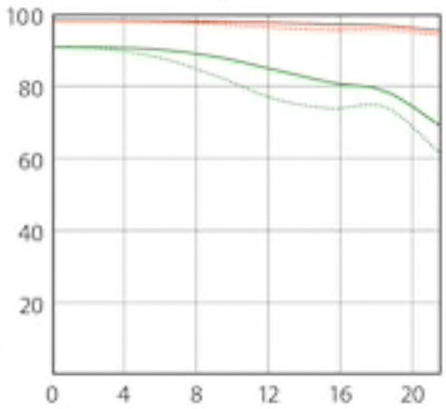 |
MTF at 60mm at f/5.6. |
MTF at 60mm at f/8. |
Spherochromatism performance top
Spherochromatism, also called secondary spherical chromatic aberration or "color bokeh," is an advanced form of spherical and chromatic aberration in a different dimension than lateral chromatic aberration. It happens mostly in fast normal and tele lenses when spherical aberration at the ends of the color spectrum are corrected differently than in the middle of the spectrum. Spherochromatism can cause colored fringes on out-of-focus highlights, usually seen as green fringes on backgrounds and magenta fringes on foregrounds. Spherochromatism is common in fast lenses of moderate focal length when shooting contrasty items at full aperture. It goes away as stopped down.
Lenses this slow usually don't suffer from spherochromatism, and this lens has very little:
Mondaine A132.30348.11SBB at close-focus distance at 60mm at f/5.6, 21 January 2021. bigger or camera-original © file.
1,200 × 900 pixel crop from above. bigger or camera-original © file.
If this 1,200 × 900 pixel crop is about 3" (7.5cm) wide on your screen, then the complete image printed at this same large magnification would be about 10 × 15" (25 × 38cm).
If this 1,200 × 900 pixel crop is about 6" (15cm) wide on your screen, then the complete image printed at this same high magnification would be about 20 × 30" (50 × 75cm).
If this 1,200 × 900 pixel crop is about 12" (30cm) wide on your screen, then the complete image printed at this same extreme magnification would be about 40 × 60" (1 × 1.5 meters).
Image Stabilization performance top
This lens has no Optical Image Stabilization (OIS, IS or VR (Vibration Reduction)), instead hoping you have a camera with sensor-shift stabilization.
Sensor-shift never works as well as in-lens, as I'll show.
"Percent Perfectly Sharp Shots" are the percentage of frames with 100% perfect tripod-equivalent sharpness I get when I'm shooting hand-held while free-standing with no support or bracing. This is a very strict test; in actual shooting at typical print sizes I get acceptable sharpness at much slower speeds, but for the purposes of seeing how much improvement an IS system gives, this is the most precise method.
Hand tremor is a random occurrence, so at marginal speeds some frames will be perfectly sharp while others will be in various stages of blur — all at the same shutter speed. This rates what percentage of shots are perfectly sharp, not how sharp are all the frames:
At 28mm
| % Perfectly Sharp Shots on A7C | 1 |
1/2 |
1/4 |
1/8 |
1/15 |
1/30 |
1/60 |
1/125 |
1/250 |
| A7C Stabilization ON | 0 |
10 |
10 |
100 |
100 |
100 |
100 |
100 |
100 |
| A7C Stabilization OFF | 0 |
0 |
1 |
5 |
50 |
50 |
83 |
100 |
100 |
I see three stops of real-world improvement, which is great for an in-camera system, but not as good as the less expensive and stabilized Canon RF 24-105mm STM on the much less expensive Canon EOS RP, which gives me about five stops improvement and can give me perfectly sharp shots half the time at over one second hand-held!
At 60mm
| % Perfectly Sharp Shots on A7C | 1 |
1/2 |
1/4 |
1/8 |
1/15 |
1/30 |
1/60 |
1/125 |
1/250 |
| A7C Stabilization ON | 0 |
33 |
67 |
75 |
100 |
100 |
100 |
100 |
100 |
| A7C Stabilization OFF | 0 |
0 |
0 |
0 |
0 |
40 |
50 |
83 |
100 |
I see four and a half stops of real-world improvement, which is fantastic for an in-camera system, but not as good as the less expensive and stabilized Canon RF 24-105mm STM on the much less expensive Canon EOS RP, which gives me about five stops improvement and can give me perfectly sharp shots sometimes at over one second hand-held!
Sunstars performance top
I get great 14-pointed sunstars on brilliant points of light, but mostly at smaller apertures because this lens is so slow to begin with.
These are shot at 60mm; you'll see similar results at a stop larger at 28mm.
Likewise ignore the crazy rainbow effects at small apertures; these are sensor artifacts caused by taking a picture directly of the sun and exposing for the dark underside of a huge palm tree, and using that same palm tree to hide the sky to accentuate the stars.
Click any to enlarge:
Click any to enlarge.
Compared top
Sample Images Intro Compatibility
I'd get my 28-60mm at Adorama, at Amazon, at B&H or at Crutchfield, or eventually used at eBay if you know How to Win at eBay.
This new lens is as sharp in actual use as any other Sony FE lens. They're all pretty good; today in 2021 the only way to see much of any difference is in a laboratory; in real-world shooting, they're all sharp.
The trade-offs are size, weight, zoom range, mechanical toughness, maximum aperture and price, not sharpness.
Recommendations top
Sample Images Intro Compatibility
I'd get my 28-60mm at Adorama, at Amazon, at B&H or at Crutchfield, or eventually used at eBay if you know How to Win at eBay.
This is a great little lens. Don't let its size fool you; it takes big pictures, with a big pricetag for such a little lens.
I use a clear (UV) protective filter instead of a cap so I'm always ready to shoot instantly. I only use a cap when I throw this in a bag with other gear without padding — which is never. The UV filter never gets in the way, and never gets lost, either.
The Hoya EVO 40.5mm UV filter is the very best. It's made of hardened glass, multicoated, and additionally coated to resist dirt and fingerprints. It's usually very expensive in larger sizes, but for 40.5mm not more expensive than the much other regular filters, so just get it and live it up.
All these filters are just as sharp and take the same pictures, the difference is how much abuse they'll take and stay clean and stay in one piece. Filters last forever, so you may as well get the best since it will likely outlive you.
This 100% all-content website's biggest source of support is when you use those or any of these links to approved sources when you get anything, regardless of the country in which you live. Sony does not seal its boxes in any way, so especially with an exotic lens like this never buy at retail or any other source not on my personally approved list since you'll have no way of knowing if you're missing accessories, getting a defective, damaged, returned, non-USA, store demo or used lens. I use the stores I do because they ship from secure remote warehouses where no one gets to touch your new camera before you do. Buy only from the approved sources I use myself for the best prices, service, return policies and selection.
Thanks for helping me help you!
Ken, Mrs. Rockwell, Ryan and Katie.
© Ken Rockwell. All rights reserved. Tous droits réservés. Alle Rechte vorbehalten.
Help Me Help You
I support my growing family through this website, as crazy as it might seem.
The biggest help is when you use any of these links when you get anything. It costs you nothing, and is this site's, and thus my family's, biggest source of support. These places always have the best prices and service, which is why I've used them since before this website existed. I recommend them all personally.
If you find this page as helpful as a book you might have had to buy or a workshop you may have had to take, feel free to help me continue helping everyone.
If you've gotten your gear through one of my links or helped otherwise, you're family. It's great people like you who allow me to keep adding to this site full-time. Thanks!
If you haven't helped yet, please do, and consider helping me with a gift of $5.00.
As this page is copyrighted and formally registered, it is unlawful to make copies, especially in the form of printouts for personal use. If you wish to make a printout for personal use, you are granted one-time permission only if you PayPal me $5.00 per printout or part thereof. Thank you!
Thanks for reading!
Mr. & Mrs. Ken Rockwell, Ryan and Katie.
